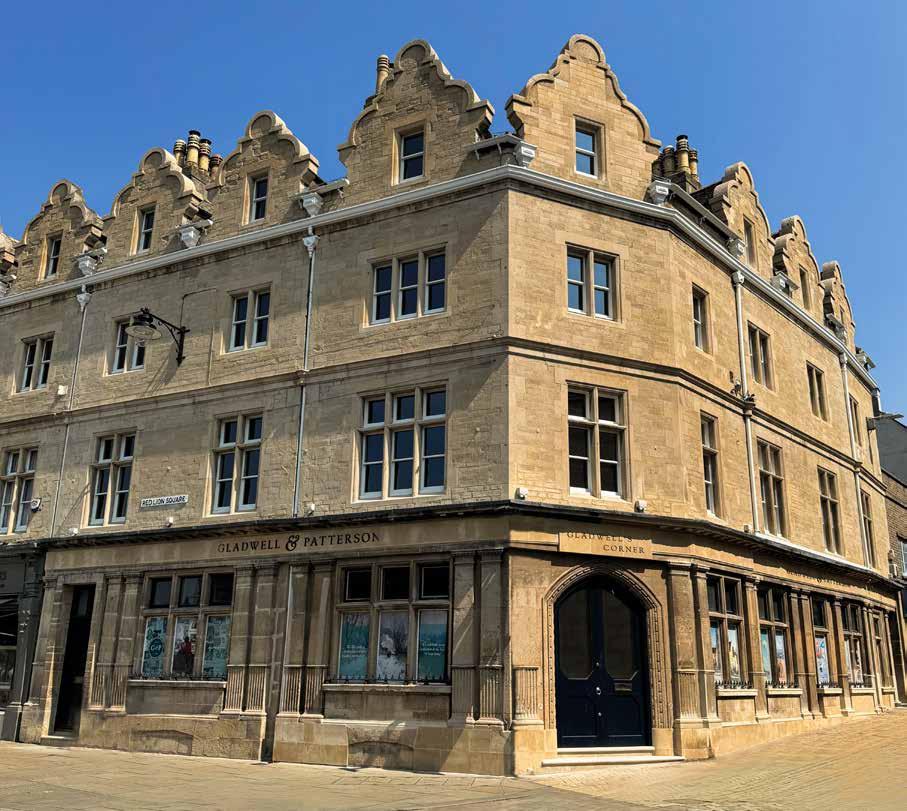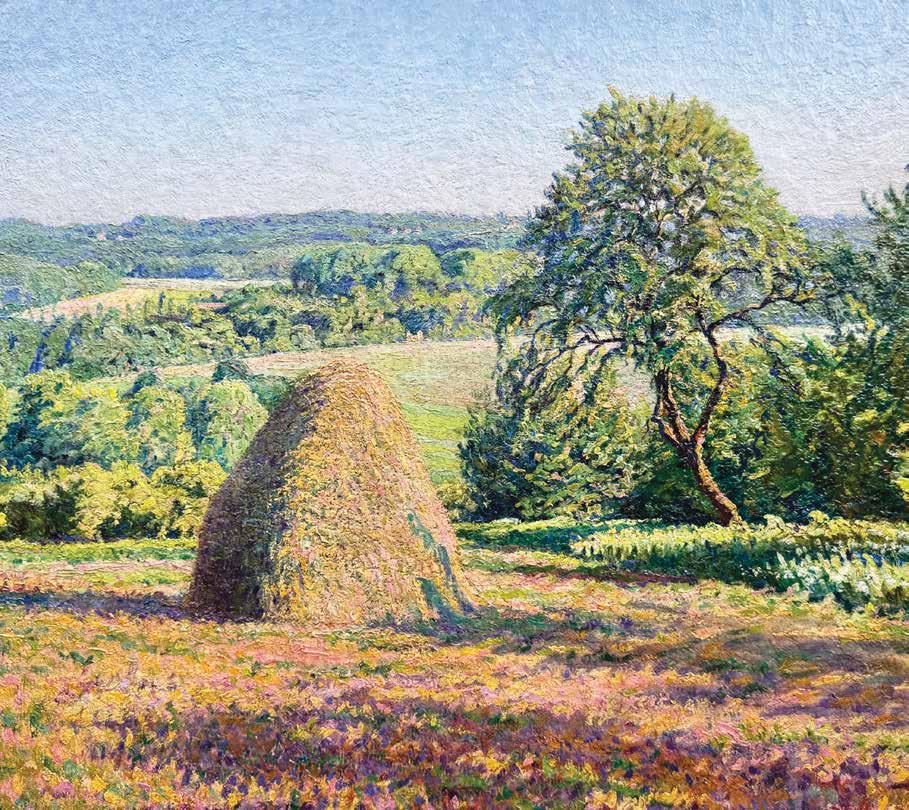

Treasures
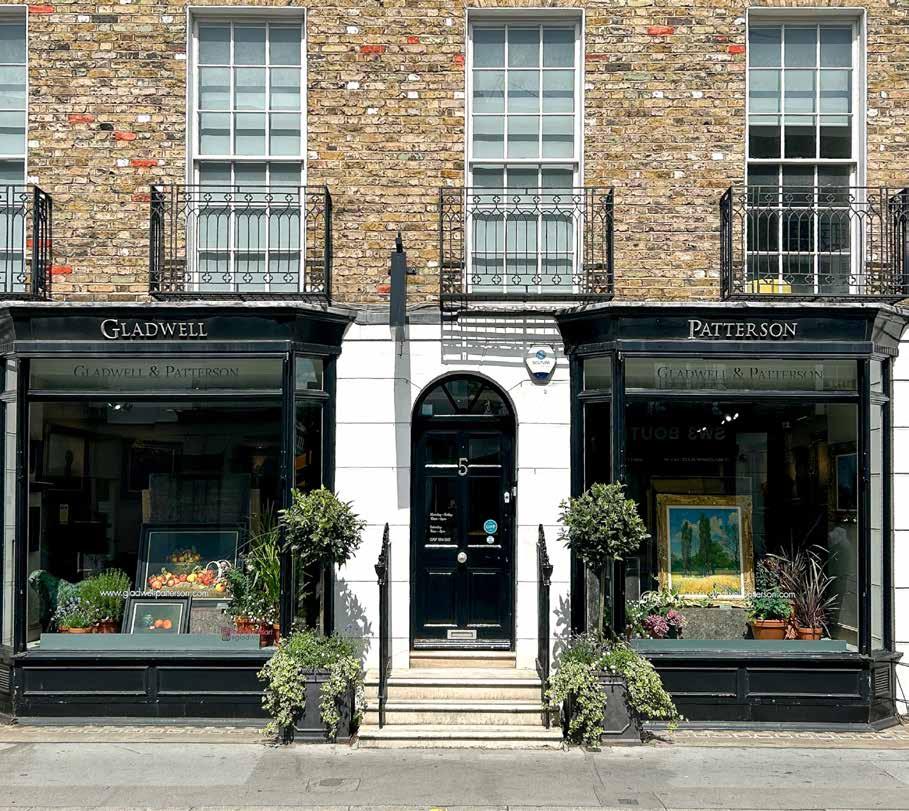
Introduction
This September marks one momentous year since we opened the doors to No. 1 High Street, our gallery in the heart of Stamford. Over the past twelve months, we’ve welcomed new faces and old friends alike, sharing in the joy of discovery, conversation and creativity. From festive wreath workshops, Garden in the Gallery and the unforgettable solo exhibition of Kenneth Webb, the year has been filled with moments to celebrate. We now look ahead with excitement to Georgina Potter’s first solo exhibition this October, a milestone that reflects her way of seeing, capturing both the British landscape and views from abroad.
This catalogue brings together a carefully curated selection of paintings and sculptures, from the monumental to the miniature, from the sun-warmed shores of the Mediterranean to the cool, quiet fields of Suffolk. There is something here for every collector: dramatic seascapes, romantic still lifes and intimate views of the natural world. Some works command with scale and drama, others invite with quiet detail. All are united by excellence, atmosphere and the artist’s hand.
We are especially proud to present Raymond Thibésart’s monumental diptych Scène de Labour and Scène de Cueillette , among the most ambitious works of his career. Alongside them sit moments of gentle observation: a scattering of puppies, a pomegranate split just so, a sluice gate caught in winter light. It is this range of scale, subject and emotional register, that gives the collection its vitality.
As ever, this catalogue is a reflection of our eye as curators and our passion as art dealers. It honours the legacy of those we have long championed and welcomes new voices into the fold. Above all, it is a celebration of the enduring power of art to move, to inspire and to connect.
We look forward to welcoming you to our galleries in London and Stamford, and to sharing our latest acquisitions with you in person in the months to come.

Gustave Cariot
French, (1872-1950)
L’Ombre et la Lumière sur la Meule
Oil on Canvas
60 x 80 cms / 23½ x 31½ inches
£57,500
Golden light bathes the French countryside in L’Ombre et la Lumière sur la Meule , where Gustave Cariot elevates a solitary haystack into a radiant emblem of harvest and harmony. The surface glistens with minute, deliberate strokes forming a tapestry of ochre, violet, sage and pearlescent hues, woven together through Cariot’s distinctive adaptation of Divisionist technique. His touch is both precise and lyrical, echoing the quiet pulse of the land as it yields to the long shadows of late summer.
Cariot’s work holds an important position in the evolution of French PostImpressionism. Though aligned with the Pointillists in method, he departed from their scientific rigor to favour a more atmospheric and intuitive approach. A self-taught painter and frequent exhibitor at the Salon des Indépendants, Cariot was admired for his ability to evoke not just the appearance of nature, but its shifting moods across time. Like Monet before him, he created seasonal series that captured the same motif under different lights, an approach seen here in the glowing serenity of this sunlit field.
Painted in the rural outskirts of Île-de-France, this landscape is unpopulated, serene and precise. The haystack anchors the composition, its form softened by the gentle rhythm of field and sky. Trees fringe the horizon in delicate counterpoint, their edges fading into the distance. Every element reflects Cariot’s fascination with nature in flux, a world distilled through light, memory and meticulous observation.

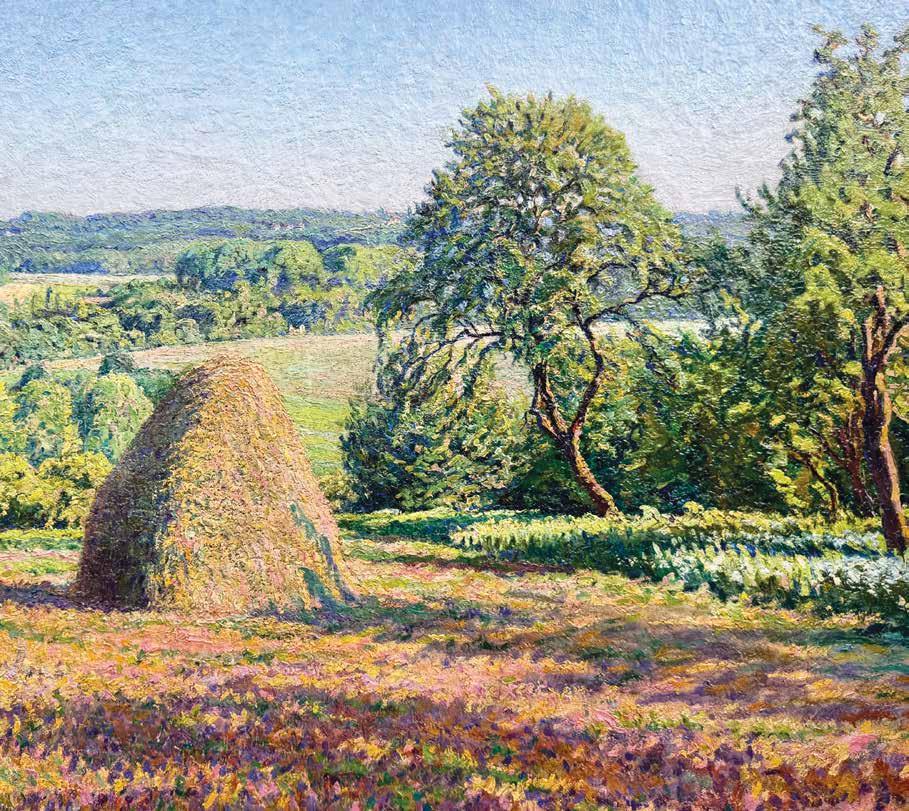
A Pair of Monumental Pastoral Landscapes
Raymond Thibésart
French (1874-1963)



Scène de Labour sur les Hauteurs de Vaux
Oil on Canvas
73 x 286 cms / 28¾ x 112½ inches

Oil on Canvas 73 x 296 cms / 28¾ x 116½ inches
Sold as a Pair for £150,000
Scène de Cueillette sur les Hauteurs de Vaux
In this extraordinary pair of panoramic paintings, Raymond Thibésart captures the spirit of rural life in France with a rare sense of harmony and grandeur. Painted at nearly three metres in width, these monumental canvases are immersive orchestrations of light and human connection to the land. They are monumental masterpieces of Post-Impressionism.
Thibésart conceived these paintings as a diptych and they have remained united since. Their compositional balance, a solitary figure in the act of ploughing in one and a communal gathering of harvesters in the other, reflects a dual meditation on perseverance and shared labour. Though painted decades after the height of French Realism, the influence of Jean-François Millet’s The Gleaners is clearly felt in the bowed postures and frieze-like spacing of the figures in Scène de Cueillette . Yet where Millet emphasised weight and hardship, Thibésart brings air and light, transforming toil into poetry.
Both compositions unfold across the hills above Vauxsur-Seine, the artist’s lifelong home northwest of Paris. Encouraged by his mentor Emilio Boggio, Thibésart settled there in 1903 and the elevated terrain became a central subject of his art.
Thibésart guides the eye across freshly turned earth toward a distant tree and village in Scène de Labour. The heavy shire horse and farmer form the painting’s steady pulse, with Thibésart’s trademark of a tree in blossom in the distance. In Scène de Cueillette , the figures move in a gentle rhythm across a sunlit slope, gathering crops under the heat of the midday sun. Together, the paintings evoke the cycles of rural life, from tilling to harvest.
Trained at the École des Beaux-Arts and the Académie Julian, Thibésart developed a Post-Impressionist style rooted in natural observation and quiet lyricism. His brushwork is confident yet restrained, with softened
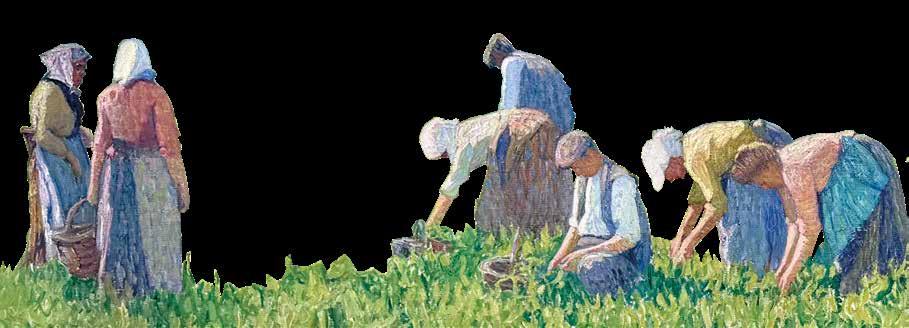

colours of pale greens, gentle pinks and powdered blues applied in a rhythm that mirrors the scenes themselves. His treatment of light, filtered and clear, reveals a debt to Corot and the Barbizon tradition, yet his vision remains unmistakably his own.
Thibésart’s mature paintings often began as en plein air pastels, later developed in the studio into larger oils. This dual approach lends the works both immediacy and refinement. Despite their scale, these two canvases retain a sense of spontaneity, the broad, sure strokes describing the figures and fields feel freshly observed, not overworked.
The sheer size, technical prowess and art historical significance makes them the most important works of Thibésart’s career and pivotal to early twentieth century French painting. They stand as a testament to the artist’s lifelong dedication to place, light and the quiet dignity of rural life.
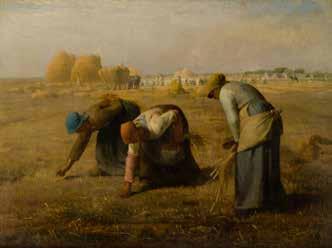
Jean-François Millet, The Gleaners , 1857 Oil on Canvas, 83.5 x 110 cm / 32¾ x 43 inches
© Musée d’Orsay, Dist. RMN-Grand Palais / Patrice Schmidt

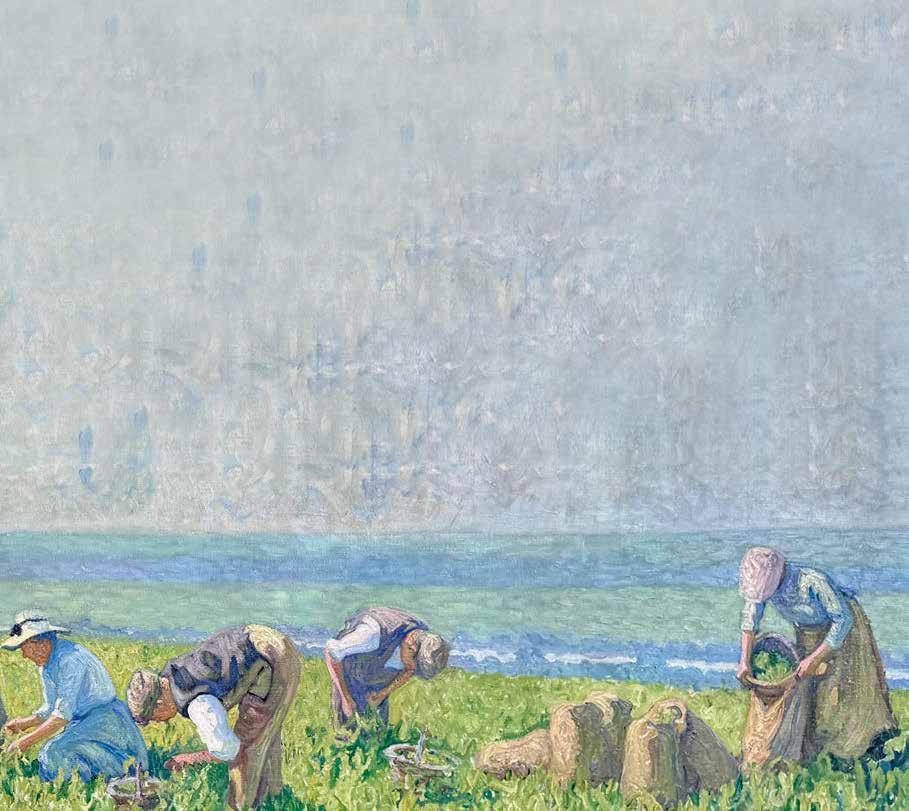
Georges Charles Robin
French (1903-2002)
L’Indre à Loches, Porte des Cordeliers
Oil on Canvas
66 x 93 cms / 26 x 36½ inches
£32,000
The paintings of Georges Charles Robin are imbued with the quiet rhythms of provincial France; sunlight on riverbanks, stone bridges arching over water, steeples rising gently above the trees. Working en plein air with an instinctive command of palette and brush, Robin returned time and again to the river valleys of the Loire and the Dordogne, capturing villages such as Loches, Grez-sur-Loing and Chartres throughout the seasons.
Robin’s work reveals an intimate understanding of his surroundings. Water is often his starting point, leading the eye through the composition. His palette is natural and harmonious, with soft greys, dusty greens and chalky blues. Avoiding the saturated tones of some contemporaries, Robin favoured quiet balance. His brushwork shifts from delicate to vigorous, always responding to light, season and mood.
A decorated exhibitor at the Paris Salon, Robin received many of the highest honours awarded to French painters of his day. Gladwell & Patterson has represented his work since the 1950s, with three generations of the gallery championing his evocative depictions of the French landscape. Today, his paintings remain a cornerstone of our collection. His compositions resonate across time, capturing the enduring charm of riverbanks and peaceful villages with his destinctive artistic vision.


Georges Charles Robin
French (1903-2002)

Bord du Loing près de Grez
Oil on Panel
54 x 65 cms / 21¼ x 25½ inches
£18,500

Oil on Canvas 48 x 59 cms / 19 x 23 ¼ inches
£18,500
La Baie de Clermont prés de Saint Brieuc, Bretagne

Maurice Martin French, (1894-1978)


Bateaux de Pêche Amarrés au Quai
Oil on Canvas
46 x 55 cms / 18 x 21¾ inches
£2,950
54.5 x 61 cms / 21½ x 24 inches
£2,950
Left Page: L’Église au Bord de l’Eau
Oil on Canvas
46 x 55 cms / 18 x 21¾ inches
£4,250
Eaux Calmes, Bretagne
Oil on Canvas
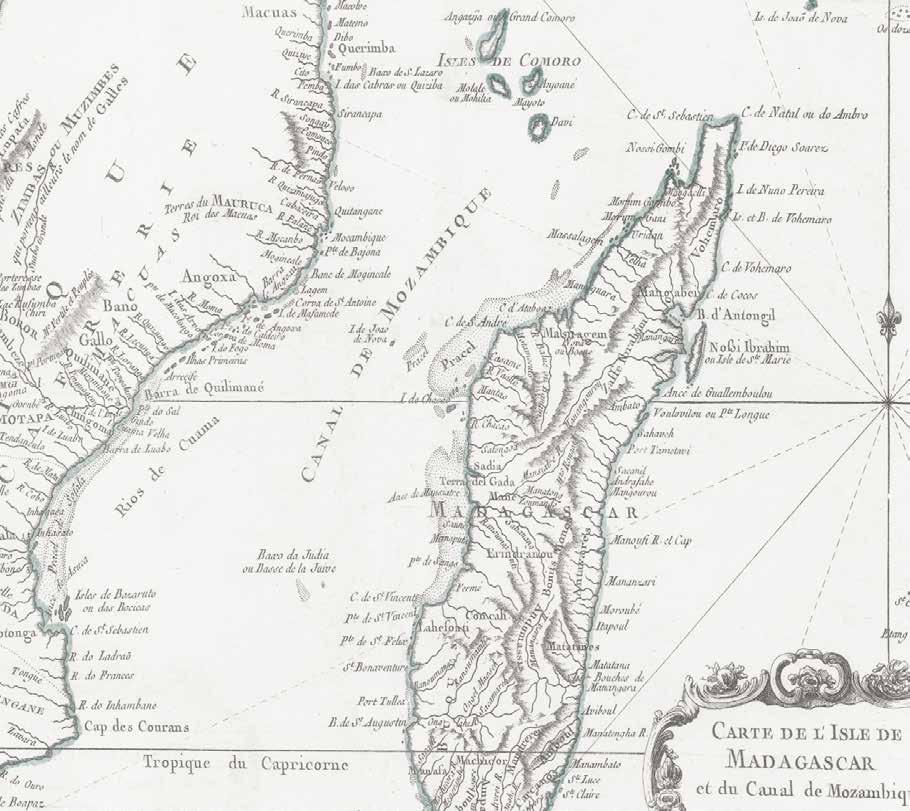
Maurice Martin
French, (1894-1978)
In a striking departure from the familiar landscapes of France, Maurice Martin’s paintings of Madagascar offer a rare and radiant glimpse into the artist’s travels beyond Europe. Painted in 1960, the year Madagascar gained its independence from France, these works form a powerful and timely series, one that reflects not only Martin’s artistic evolution but also a moment of profound historical transition.
Awarded the Prix de Madagascar at the Paris Salon in the same year, these compositions were celebrated from the outset for their originality and emotional clarity. Yet they also stand as subtle records of a newly sovereign nation, viewed through the eyes of a French painter who approached his subject with empathy, light and respect. Unlike colonial depictions of earlier decades, Martin’s Madagascar is not exoticised, but observed: its adobe villages, tropical vegetation and red earth rendered with the same honesty and painterly integrity that defined his French scenes.
The works glow with Martin’s hallmark warmth using tones such as ochres, dusty reds and jade greens, applied with broad, expressive brushstrokes and lit from within. Figures move through the landscape with purpose and ease, their forms integrated into the land rather than imposed upon it. There is a rhythm here that feels rooted in place, shaped by experience rather than projection.
As a central figure of the Moret School, Martin had

Village des Hauts Plateaux de Madagascar
Oil on Canvas 46 x 55 cms / 18 x 21¾ inches £3,950
long been associated with the en plein air tradition. In these Madagascan works, that sensibility expands outward, responding to new terrain, light and cultural textures while remaining grounded in his essential style.
We are exceptionally fortunate to have discovered this rare group of paintings depicting Martin’s Madagascan subjects. Combined with his peaceful yet vividly coloured French rural scenes, this unprecedented collection reveals the true breadth of his talent. It showcases an artist equally attuned to the poetry of his homeland and to the light, rhythm and richness of a distant landscape with each painting rendered with authenticity, empathy and the painter’s quiet grace.

Le Village d’Andohatapenaka près de Tananarive
Oil on Canvas
54.5 x 65 cms / 21½ x 25½ inches
£3,950

Vue de Marché à Madagascar
Oil on Canvas
46 x 55 cms / 18 x 21¾ inches
£3,950

Sur les Bords de la Lagune de Mananjary
Oil on Canvas
54.5 x 65 cms / 21½ x 25½ inches
£3,950


Alexandre Louis Jacob French
(1876-1972)
Neige dans L’Oise
Oil on Canvas
99 x 81.5 cms / 39 x 32 inches
£25,000
Few painters have captured the softness of northern France with the quiet authority of Alexandre Louis Jacob. From the banks of the Marne and the Seine to the frosted fields of the Oise, Jacob returned to the same river valleys year after year, finding endless variety in the changing light, shifting skies and reflections cast on still water.
His landscapes are understated yet profoundly atmospheric. A low winter sun diffused through cloud, the delicate shimmer of snow on a riverbank, a plume of chimney smoke rising over a tiled farmhouse roof - these are the moments Jacob excelled at preserving. His compositions are calm, often anchored by poplars or low horizon lines with vast, everpresent skies that carry the full emotional weight of the scene.
Jacob worked en plein air but never chased spectacle. He preferred the hush after a storm, the quiet thaw of early spring, or the warm haze of a September afternoon. His palette shifted with the seasons: pale blue and mauve in winter, ochre and grey-green in autumn, always tempered and finely judged.
Jacob’s appeal lies in this subtlety. He invites contemplation, not drama. Awarded the Hors Concours at the Paris Salon where he exhibited for over five decades, Jacob earned considerable acclaim during his lifetime. Since the 1950s, Gladwell & Patterson has been privileged to handle his work, placing it in important private collections across the world. In every composition, there is a sense of stillness and integrity, a moment observed and remembered with great care.
Gustave Loiseau
French (1865-1935)
Glaçons sur l’Oise
Painted in 1914
Oil on Canvas
60 x 81 cms / 23½ x 32 inches
£89,500
A frozen hush lingers over the River Oise in Glaçons sur l’Oise , painted during one of the coldest winters in northern France. Loiseau presents a rare moment of stillness. The iron bridge of Pontoise anchored across the canvas, while the ice-laden surface of the Oise reflects a pale winter sky. On the far bank, the town is shrouded in quiet; rooftops and chimneys emerge through a veil of cold light, softened by the season’s stillness.
Painted in 1914, this work captures both a moment in nature and a point of rupture in time. That same year, France would enter the First World War. Loiseau’s painting portrays a world momentarily frozen, the calm before the storm. The Pointoise railway bridge would later be destroyed alongside many other canal bridges in the First World War to slow the advancing armies. This painting plays a significant role in the preservation of the French landscape prior to the war, adding a layer of historical resonance that deepens the quiet power held within the painting.
The painting was acquired directly from the artist in
1914 by the legendary dealer Durand-Ruel, who recognised its power and exhibited it in his gallery, a mark of its quality and of Loiseau’s standing among the most significant painters of his time.
Following the success of his first three exhibitions with Durand-Ruel, Loiseau acquired land in Pontoise in 1903, on the banks of the river Oise on the Quai de Pothuis where he proceeded to build his home and studio over the following two years. Pontoise would become an anchor throughout the artist’s life and career, and where he would return in the winter, having travelled extensively during the summer months in Normandy, Brittany and the Dordogne, seeking out suitable subject matters.
At Pontoise, Loiseau followed in the footsteps of Camille Pissarro and Alfred Sisley but forged a distinctive path of his own. Throughout the 1910s Loiseau developed his signature technique, known as en treillis or cross-hatched brushwork, which lends the surface a rhythmic vitality. In Glaçons sur l’Oise , he applies this with particular delicacy: cool greys and icy blues intersect with mauves and soft creams, creating a luminous, almost tonal harmony.
As a key figure in Post-Impressionism, Loiseau balanced fidelity to the landscape with a deep sensitivity to the change of weather, time and atmosphere. He had little interest in grand subjects, preferring the everyday poetry of rivers, villages and rural life. This painting is a masterclass in restraint: quiet, contemplative and exquisitely observed. It is a rare opportunity to witness Loiseau at his most introspective, when even the river seems to pause and breathe.

Raymond Thibésart
French (1874-1963)

de Noël
Oil on Canvas
32.5 x 41 cms / 12¾ x 16¼ inches
£5,500
Roses
Marcel Dyf
French, (1892-1953)
55 x 46 cms / 21¾ x 18 inche
£23,000
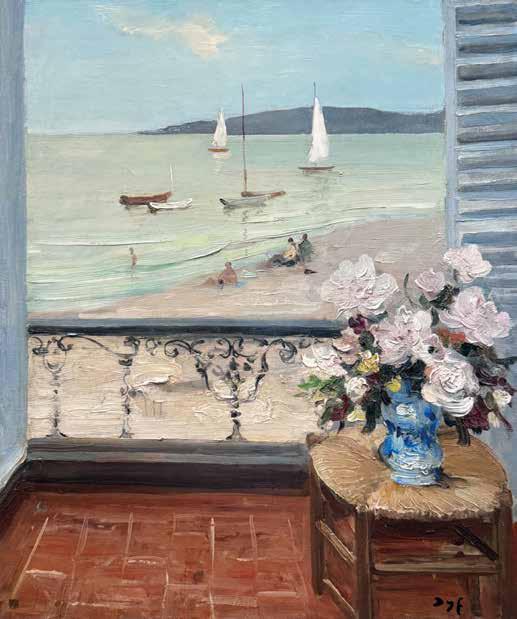
Vue sur la Côte, Fenêtre Bleue
Oil on Canvas
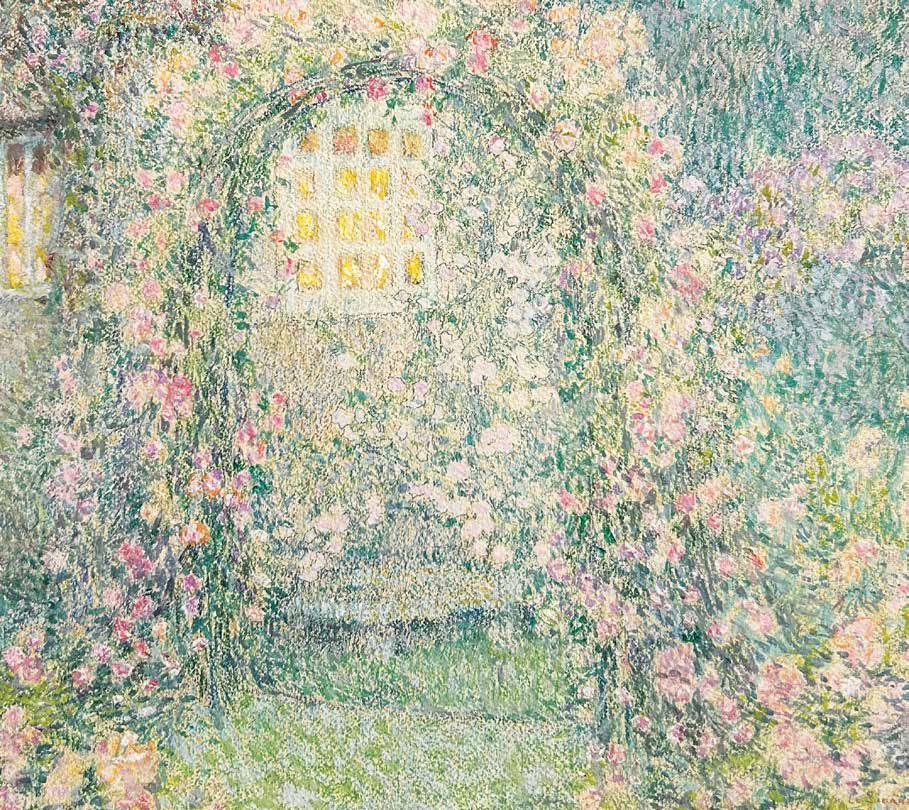
Henri Le Sidaner
French, (1862-1939)
The Rose Garden, Gerberoy
Executed in 1923
Gouache, Coloured Pencils and Pastel on Paper
33 x 40 cms / 13 x 15¾ inches
£85,000


Bathed in the soft half-light of evening, The Rose Garden, Gerberoy is among the most tender and poetic of Henri Le Sidaner’s garden scenes - a twilight reverie captured with gentle precision. Painted at his beloved home in Gerberoy, the work is a tribute to the rose garden he described simply as “the favourite corner of my life.”
Gerberoy, the medieval village Le Sidaner adopted in 1901, became both his sanctuary and enduring muse. There, he transformed a hillside into a sequence of quiet terraces, pergolas and flowering borders, a stage for the changing light and an endless source of inspiration. Between 1901 and 1934, he painted dozens of views of this rose garden, each a study in nuance and atmosphere.
In this delicate work on paper, Le Sidaner renders the pergola with a soft haze of pink, ivory and slate, as if seen through memory or fading light. There are no figures or narrative, only the gentle invitation to pause and observe as forms dissolve into the stillness.
A leading figure of the Intimist movement, Le Sidaner merged Impressionist technique with Symbolist sensibility. He was drawn not to spectacle but to silence and to the poetry of the everyday. The Rose Garden, Gerberoy exemplifies that vision. Intimate in scale, yet rich in mood and meaning; it is a love letter to a place, and to the fleeting beauty of light as day gives way to night.
Fernand Pinal
French, (1881-1958)

Oil on Canvas
39 x 46 cms / 15¼ x 18 inches
£12,500
Arbres en Fleurs
Raymond Thibésart
French, (1874-1963)

Pommiers en Fleurs
Oil on Panel
60 x 81 cms / 23½ x 32
£45,000
Yvonne
Canu
French, (1921-2008)
Le Golfe de Saint Tropez
Oil on Canvas
37 x 44.5 cms / 14½ x 17½ inchess
£23,000
In Yvonne Canu’s luminous vision of Le Golfe de Saint-Tropez , the Mediterranean shimmers in a mosaic of radiant colour. The sea glints with dappled blues and soft lilacs, while the ochre walls of the harbourfront glow beneath a haze of Provençal light. Rendered in Canu’s signature Pointillist technique, the scene feels both crystalline and serene. Her pointillist method, involving small, precise dots of pure colour, allowed her to capture the luminosity of this environment in a unique and dynamic way.
Canu’s signature style developed from a single encounter with George Seurat’s famed seminal pointillist work, Sunday Afternoon on the Grand Jatte , in 1955. Struck by how complex contrasts of primary and tertiary colours could coalesce into intensely lit landscapes, Canu wholeheartedly adopted the style, after experiencing Seurat’s work she would begin to exclusively work in a Neo-Impressionist idiom.
Canu’s contributions to the Neo-Impressionist movement are particularly noteworthy within the context of a male-dominated art world of the twentieth-century. Of particular note was a 2016 retrospective exhibition of her works on the banks of Lake Lugano, titled ‘Yvonne Canu: The Last of the Pointillists’ that showed her oeuvre alongside works by Signac, Seurat and Foujita. With her mastery of juxtaposition and meticulously delineated composition, Canu remains one of the final paradigms of Neo-Impressionism.


Pierre Bittar
French, (b. 1934)
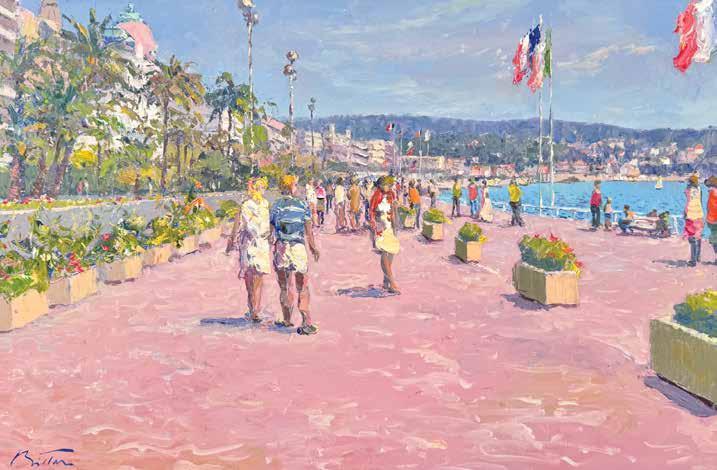
61 x 91 cms / 24 x 35 ¾ inches
£7,500
La Promenade des Anglais, Nice
Oil on Canvas
Yvon Grac French, (b. 1945)
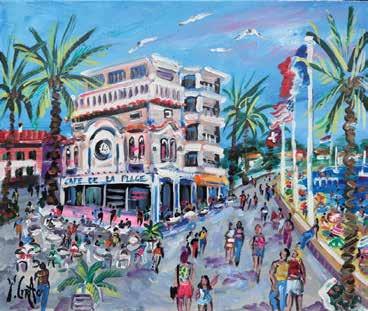

Ambiance Estivale autour du Café de la Plage à Juan Les Pins
Oil on Canvas
45 x 55 cms / 17¾ x 21¾ inches
£3,950
Nice, le Negresco et la Baie des Anges
Oil on Canvas
50 x 61 cms / 19¾ x 24 inches
£2,950
Gabriel Deschamps
French, (1919-1980)
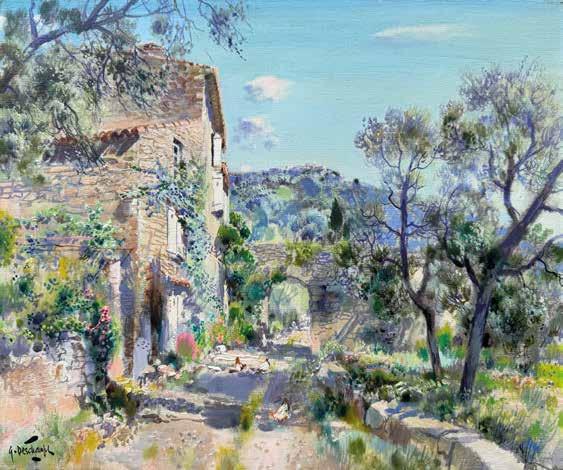
Oil on Canvas
46 x 55 cms / 18 x 21¾ inches
£5,950
Bastide du Porche
Lucien Potronat
French, (1889-1974)
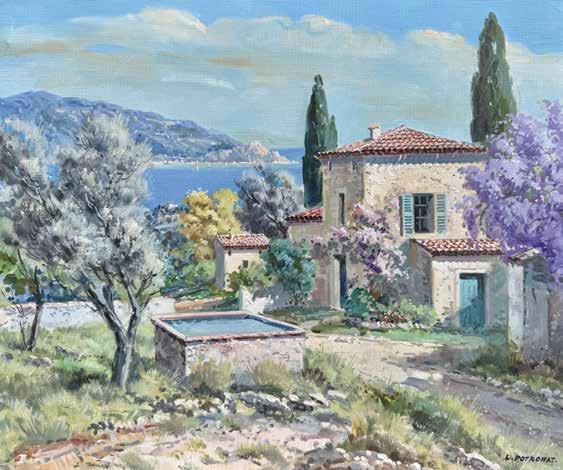
Spring, South of France
Oil on Canvas
44 x 54 cms / 17¼ x 21¼ inches
£1,950

Jean Kevorkian French (1933-2019)
L’Étang aux Nympheas
Oil on Canvas
74 x 61 cms / 29 x 24 inches
£9,500
Oil on Canvas
74 x 93 cms / 29 x 36½ inches
£15,000
Right: Sentier Longeant la Rivière


Charles Perron French (1893-1958)

Left Page: La Porte Fleurie
Oil on Canvas
46 x 55 cms / 18 x 21¾ inches
£5,950
La Trinité-sur-Mer, Bretagne
Oil on Panel
37 x 45 cms / 14½ x 17¾ inches
£4,950
Raymond Wintz
French (1884-1956)

Dans la Cour du Manoir, Finistère
Oil on Canvas
54 x 65 cms / 21¼ x 25½ inches
£5,950
Right Page: Bretonne devant sa Porte
Oil on Canvas
46 x 55 cms / 18 x 21¾ inches
£4,950
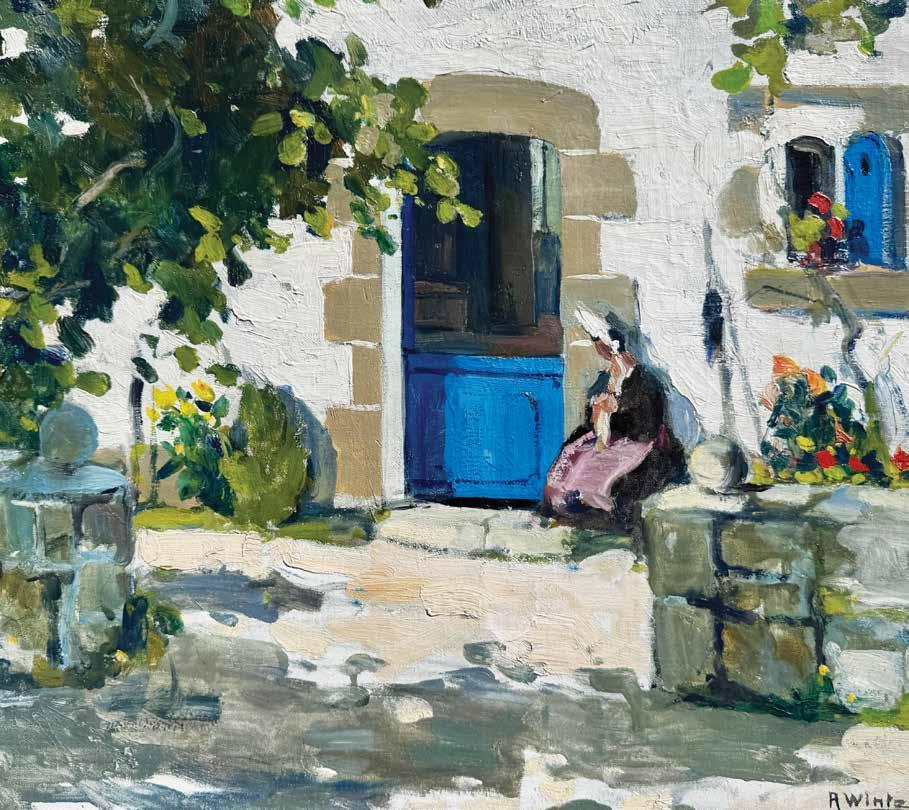
Raymond Wintz
French (1884-1956)
Bretagne, Retour de Pêche
Oil on Canvas
114 x 145 cms / 45 x 57 inches
£19,500
Celebrated as a painter of light, Raymond Wintz enjoyed a reputation as one of the finest artists working in France in the early twentieth century. Renowned for his skilful use of colour, he gained critical and collector acclaim for his depictions of the Brittany coastline, particularly his sunlit window and balcony scenes that evoke memories of seaside holidays.
Drawn to the region’s beauty and unique light, especially in Finistère in Brittany, Wintz captured idyllic seascapes and river estuaries. His detailed portrayal of traditional Breton life - fishing boats, fishermen and bigoudènes in native dress - transport the viewer into this unspoilt and cherished environment. His soft, luminous palette brings Brittany’s atmosphere to life, continuing to captivate collectors today.
Gladwell & Patterson’s history with this distinguished artist began after the Second World War. Glenn and Cory’s grandfather, Herbert, discovered his work following Wintz’ election as President of the Jury of the Paris Salon in 1953. Since he first set eyes on Wintz’ landscapes in Paris, Herbert and the two subsequent generations of the Fuller family of Gladwell & Patterson have continued to share the legacy of this great artist.

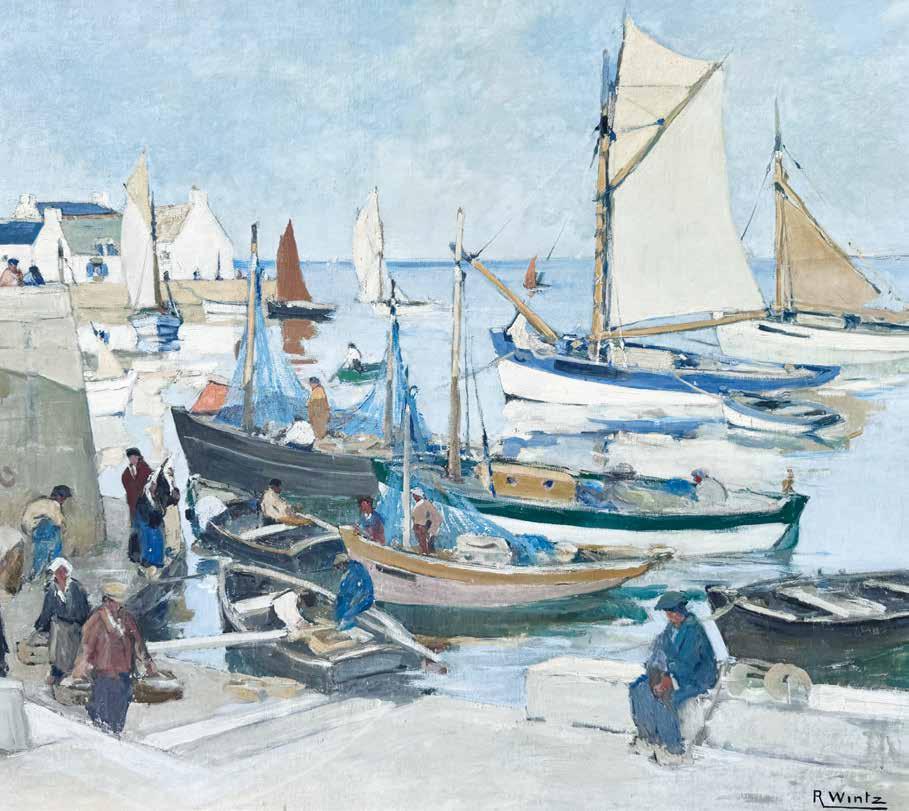


Jules Masuré French,
(1819-1910)
Coucher du Soleil
Oil on Canvas
75 x 105 cms / 29½ x 41¼ inches
£23,000
Bathed in the glow of a fading sun, Au Coucher du Soleil is a masterful portrayal of atmosphere and light. Jules Masuré captures a moment of profound stillness as the last light slips across the surface of the sea, transforming water, sky and cloud into a symphony of lilac, rose and silver. A solitary sailboat appears just left of centre, its dark silhouette catching a whisper of the remaining daylight as it drifts slowly into the horizon.
Masuré belonged to a generation of late nineteenth-century and early twentieth-century French painters who sought to reconcile academic naturalism with the fleeting effects of Impressionism. Painting the northern coastlines of Normandy and Brittany, he was drawn to the elemental rhythms of sea and sky, portraying these subjects with a quiet sensitivity and technical assurance that speak to both observation and emotion.
A rare example of Masuré’s mature coastal work, this painting speaks to the timeless pull of the sea and the painter’s abiding fascination with the ephemeral.
Au
Ronny Moortgat
Belgian (Contemporary)
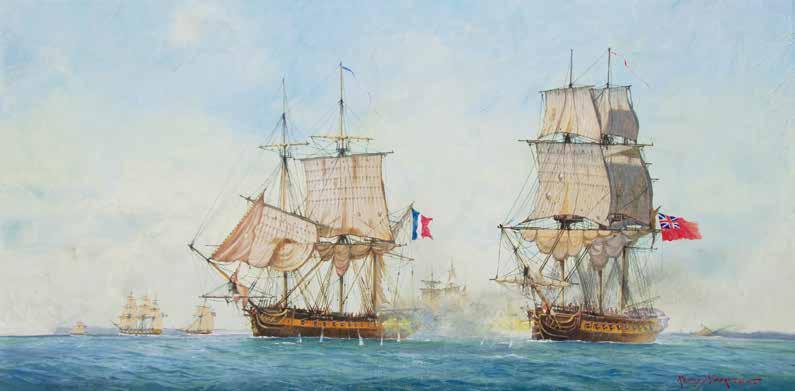
Action Between HMS Hydra and La Confiante, 1798
40 x 80 cms / 16 x 32 inches
£9,500
Watercolour
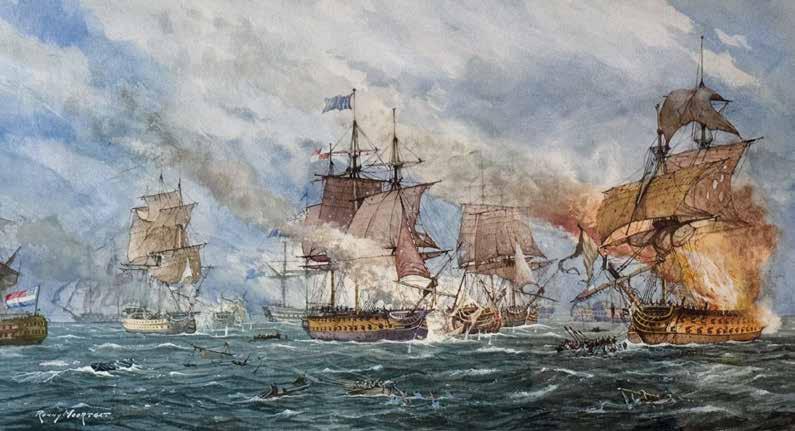
The Battle of Camperdown
Watercolour
29.8 x 55 cms / 11¾ x 21¾ inches
£9,500
Ronny Moortgat brings to life two pivotal naval engagements from the French Revolutionary Wars with these two watercolours. With astonishing clarity and control, Moortgat captures the fury and precision of late eighteenth-century naval warfare. In each scene, whether the large-scale confrontation of Camperdown or the tense skirmish off the coast of Brittany, his brush conveys the taut drama of sails under fire, cannon smoke drifting across sea and sky, and the relentless momentum of ships locked in combat. Moortgat’s meticulous attention to rigging, hull detail and weathered seas reflects not only historical accuracy but a deep reverence for maritime tradition. These paintings are more than depictions of battle, they are tributes to the courage, strategy and atmosphere of an era when supremacy at sea shaped the course of nations.
Émil-Bénédiktoff Hirschfeld
Ukrainian, (1867-1922)
Returning to Home
Oil on Canvas
34 x 66 cms / 13½ x 26 inches
£9,950
Émil - Bénédiktoff Hirschfeld’s Returning to Home captures the sea at its most poetic. Waves crest and fall in a cool palette of blues and greens, while luminous golden reflections dance across the surface. A solitary sailboat drifts into the distance, its light silhouette balanced against the vastness of sea and sky, hinting at a journey’s end in serene return.
Born in Odessa in 1867, Hirschfeld refined his craft through formal studies in Munich and Paris before settling in Concarneau, Brittany, in 1891. Immersed in the rich maritime traditions of the region, he produced seascapes infused with both realism and atmosphere. His work received early recognition; at the Paris Salon, he earned an honorable mention in 1892 and went on to win a gold medal two years later. His paintings frequently depict the rhythms of Breton life with a nuanced command of light and color, balancing Impressionist sensitivity with realist discipline.
Hirschfeld’s brushwork conveys both motion and stillness, suggesting emotional resonance beneath the ocean’s surface. The painting speaks of the natural world’s power to stir the spirit, rendered by an artist rooted in tradition yet inspired by the flux of light, water and gentle memory.

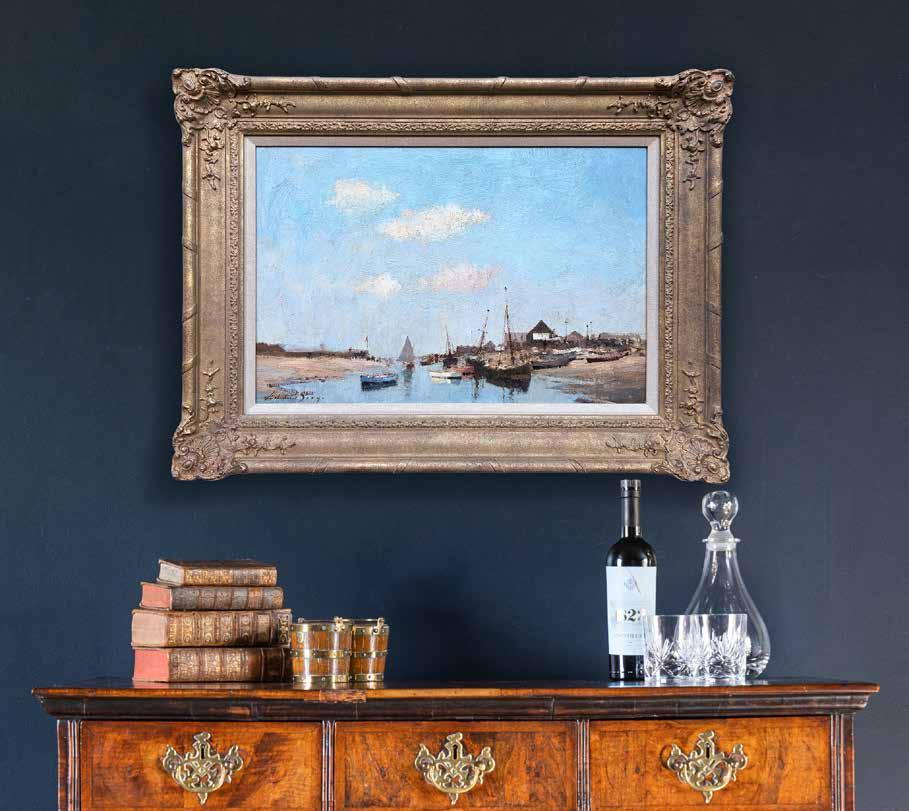
Edward Seago
British (1910-1974)
Low Tide at Bawdsey, Suffolk
Oil on Board
39.5 x 59 cms / 15½ x 23¼ inches
£59,500
Edward Seago’s serene British landscape of Low Tide at Bawdsey, Suffolk captures a fleeting, tranquil moment along the Suffolk coast, where land, water and sky meet in quiet harmony. The painting distils Seago’s deep connection to East Anglia, a region he knew intimately and returned to often, into a composition of remarkable balance, atmosphere and restraint.
Across the canvas, the eye is drawn first to the vastness of the sky. Painted with fluid, expressive strokes, it is luminous yet weightless, a dome of soft light that hovers above the shoreline. Below, the reflective water gently breaks against the mudflats, where moored boats sit suspended between sea and sky. The scene is still, but never static, there is a sense of shifting tide and of weather passing through.
Bawdsey, a small village where the River Deben meets the North Sea, was among Seago’s favoured subjects. Its working shoreline, wide estuary views and ever-changing light provided the perfect setting for his plein-air sensibility. Here, the palette is cool and harmonious, greys, blues and warm earth tones held in careful tension.
Though entirely grounded in place, Low Tide at Bawdsey, Suffolk is ultimately a painting of atmosphere. With elegant economy, Seago invites the viewer to pause, to watch the boats drift, to trace the light across the sky and to enter into the rhythm of tide and time.
Edward Seago
British (1910-1974)
Landscape Near Blythburgh, Suffolk
Oil on Board
39.5 x 59 cms / 15½ x 23¼ inches
£37,500
Soft light filters across the fields near Blythburgh, illuminating the Suffolk countryside in one of Edward Seago’s most contemplative scenes. Windswept trees bend gently in the foreground, silhouetted against a sky in flux: clouded, luminous and expansive. The land undulates toward the horizon in rhythmic furrows and scattered hedgerows, touched by fleeting glints of sun.
Seago frequently visited the Blythburgh’s tidal estuary, where the rolling fields and wide skies offered him the perfect inspiration for mood and atmosphere. This painting captures the area’s elusive beauty - the stillness after a storm and the hush before the weather turns again. The eye is drawn along a diagonal path from land to sky, from the intimacy of foreground texture to the airy vastness above.
Executed with Seago’s signature blend of looseness and control, the brushwork here is confident and textured. Clouds are shaped with sweeping gestures, while the land is described with firmer, more deliberate strokes. Subtle modulations of colour, from pale blues to ochres and mossy greens, give the composition both structure and softness.
Seago’s art has always resided in restraint. Rather than dramatise the landscape, he invites the viewer to experience it slowly. In this quiet moment near Blythburgh, he offers a mood, a memory, a feeling held gently in paint.

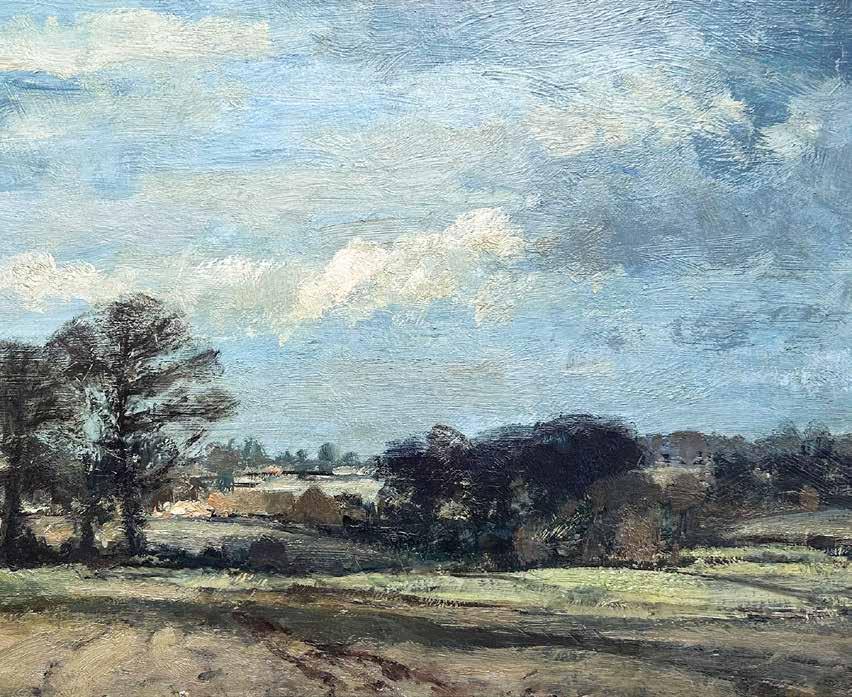

Alfred de Breanski British, (1852-1928)
Under the Skies of Inversnaid
Oil on Canvas
29 x 39 cms / 11½ x 15¼ inches
£17,500
Beneath towering Highland skies, Alfred de Breanski offers a scene of arresting solitude and grandeur. He captures the remote beauty of Scotland’s western reaches, where loch and land meet under shifting clouds and ancient light.
Inversnaid, on the eastern shores of Loch Lomond, was one of Breanski’s most favoured subjects. Here, he finds a quiet harmony between the rugged topography and the soft drama of the sky. A cluster of sheep graze near the water’s edge, lending scale and intimacy to the wide, open setting. The mountains rise gently behind them, wrapped in soft mist and distant haze.
Breanski’s palette is rich yet natural, earthy browns, moss greens and subtle lavenders blend across land and heathered slope, while the sky, brushed with light, moves from pale gold to slate grey. His attention to texture is distinctive: the bracken, the glint of water, the clouded peaks all rendered with a deep sensitivity to place.
Trained in the academic tradition yet shaped by a Romantic vision of landscape, Breanski developed a style that balances precision with poetry. His Highland scenes are not idealised fantasies, but meditations on light, weather, and terrain. In this painting, as in many of his finest works, he captures not just the look of the land, but its quiet, enduring spirit.

Peter Symonds British (Contemporary)
Last Light
Oil on Canvas
15 x 23 cms / 6 x 9 inches
£1,250
River Tillingbourne, Abinger Hammer, Surrey
Oil on Canvas
20.5 x 30.5 cms / 8 x 12 inches
£2,500
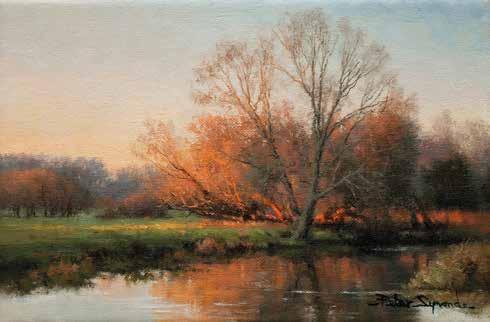

Evening Light, Sennen Cove, Cornwall
Oil on Canvas
20.5 x 38 cms / 8 x 15 inches
£2,750
From the granite cliffs of Cornwall to the wooded banks of the River Wey, Peter Symonds invites the viewer into a world of quiet majesty and luminous detail. His paintings, reveal a profound sensitivity to light, weather and terrain. An avid walker and mountaineer, Peter has climbed the very peaks and trodden the footpaths that later appear in his work. His intimate knowledge of each location, earned on foot and in all weathers, lends his compositions a rare authenticity and emotional depth. Every canvas begins with a walk, each view is shaped by experience.
Working exclusively in oils, Peter distils atmosphere through a balance of expressive brushwork and crisp detail. His paintings reveal a lived experience: the crispness of Highland air or the hush of dusk on Cornish sands. Peter’s paintings are reflections of a life spent outdoors and are a tribute to the places that have stirred him most.
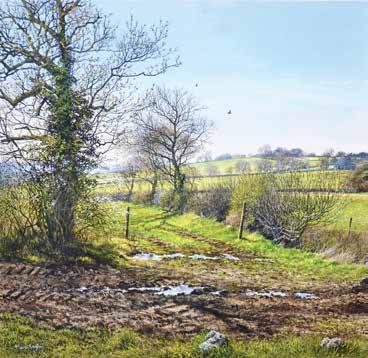
Martin Taylor British (Contemporary)
The Awakening of Spring
Watercolour
43 x 45 cms / 17 x 17¾ inches
£4,250
Tracks - Spring
Watercolour
40 x 40.5 cms / 15¾ x 16 inches
£3,950

A Warm Winter’s Day
Oil on Canvas
28.5 x 32 x cms / 11¼ x 12½ inches
£4,950

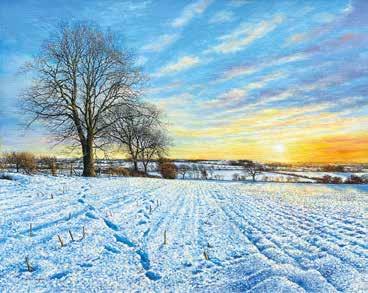
Sunsets Over Snowy Fields, East Haddon
Oil on Canvas
40 x 50 cms / 15¾ x 19¾ inches
£5,450
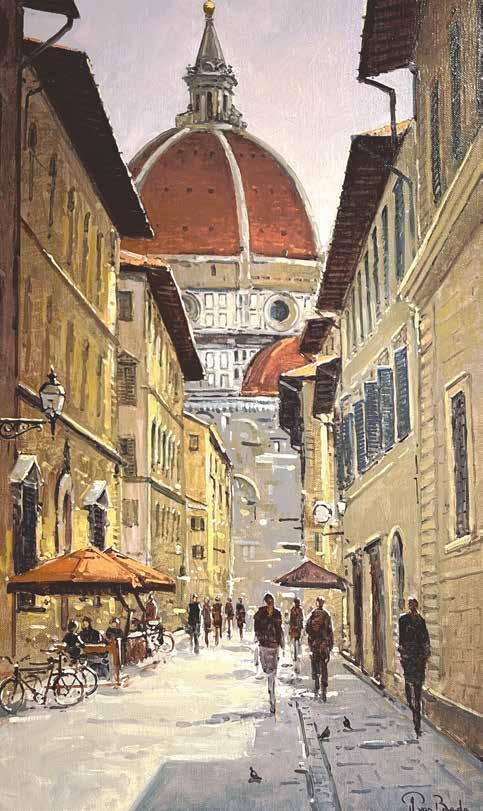
Peter van Breda
British (Contemporary)
Duomo, Florence, Via dei Servi
Oil on Canvas
54 x 31 cms / 21¼ x 12¼ inches
£4,250
Dappled light, Albert Bridge,
Oil on Canvas
46 x 55 cms / 18 x 21¾ inches
£5,250
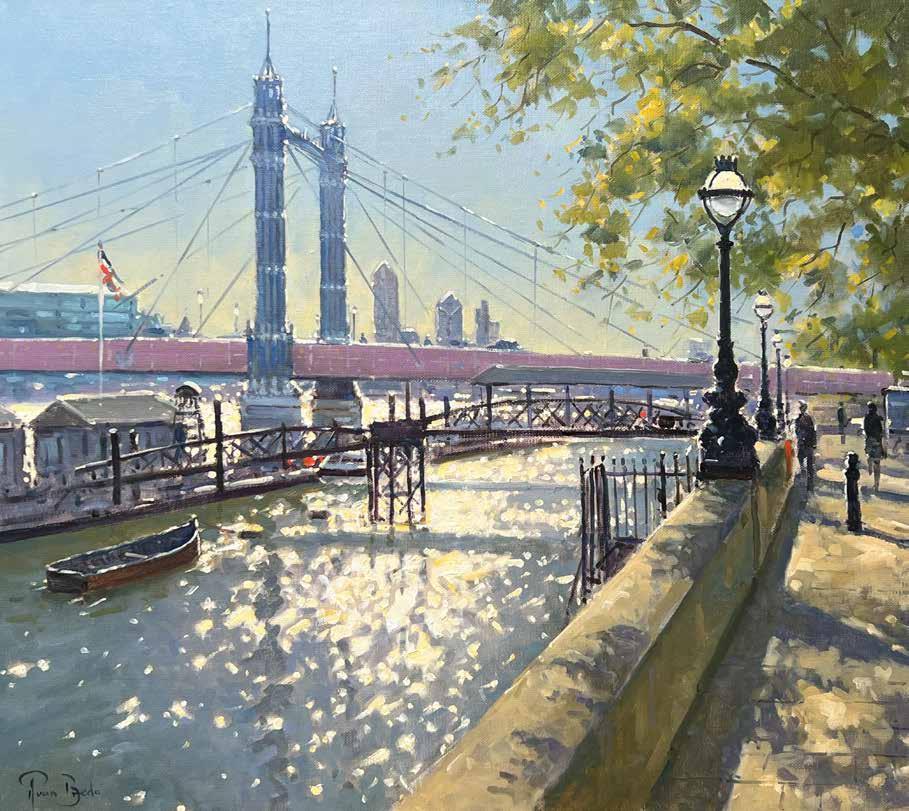

Golden Hour, The Mediterranean
Signed ‘Pelletier’ Oil on Canvas
33 x 46 cms / 13 x 18 inches
£6,950
Twilight Reflections, The Mediterranean
Signed ‘Pelletier’ Oil on Canvas
33 x 46 cms / 13 x 18 inches
£6,950

Auguste Bouvard
French, (1875-1956)
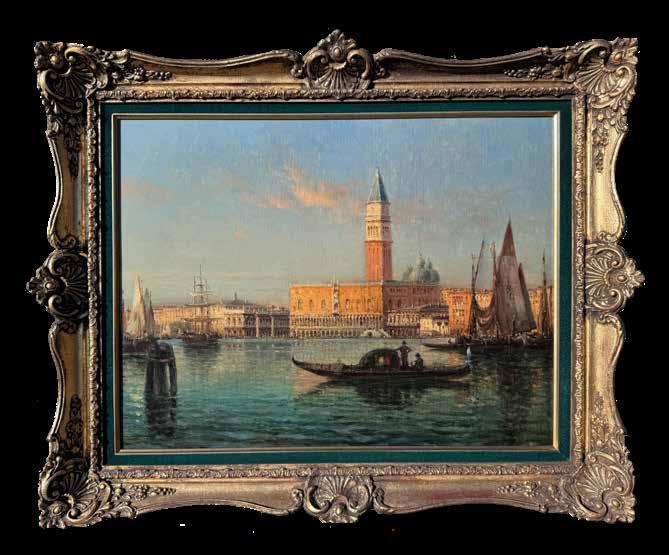
The Doge’s Palace Oil on Canvas
45 x 64 cms / 17¾ x 25¼ inches
£19,500
David Shepherd
British (1931-2017)
Masters of Tsavo
Painted in 1985
Oil on Canvas
61 x 111 cms / 24 x 43¾ inches
£69,500
David Shepherd presents three towering bull elephants with the majesty and reverence of portraiture. Painted in 1989, Masters of Tsavo is a powerful tribute to the African giants that captured Shepherd’s imagination from the earliest days of his career and whose fate would define much of his life’s work.
Set against the ochre dust and heat-hazed horizon of Kenya’s Tsavo National Park, the central bull stands dominant. Its ivory tusks gleaming, its gaze unflinching. Flanking him are two companions, each rendered with arresting detail. Their wrinkled skin, heavy limbs and weathered presence are painted with Shepherd’s trademark precision. Yet beyond accuracy lies something deeper: empathy. These are not generic symbols of wilderness, but individual creatures, observed and honoured.
Tsavo, with its red earth and expansive skies, held special significance for Shepherd. It was there, as a young artist, that he first encountered elephants in the wild, an experience he described as transformative. He later called Tsavo “the finest place to see the African elephant,” and returned often, both in person and in paint.
By the time Masters of Tsavo was completed, Shepherd had become one of the most recognised wildlife painters of his generation. In 1984, he founded the David Shepherd Wildlife Foundation, channelling the success of his art into conservation. This painting, poised between artistry and activism, stands as one of his most iconic compositions. It is a majestic salute to a vanishing world and a plea to protect it.
Bronze Sculpture photographed here is by Edward Waites, Running Warthog , 45 x 33 x 13 cms / 17¾ x 13 x 5 inches, £6,250

David Shepherd
British (1931-2017)

Elephants in the Savannah
Painted in 1986
Oil on Canvas
23 x 40.5 cms / 9 x 16 inches
£39,500

The Watch Oil on Canvas
30.5 x 51 cms / 12 x 20 inches
£39,500




David Shepherd British (1931-2017)
Muffin’s Pups
Painted in 1983
Oil on Canvas
44 x 59 cms / 17¼ x 23¼ inches
£32,000
Renowned for his commanding portrayals of African wildlife, David Shepherd brings the same care and conviction to the intimate subject of Muffin’s Pups . Painted with affection and insight, this portrait of eight tumbling puppies from the first litter of the artists family’s beloved bearded collie, Muffin. David captures a moment of joyful chaos and irresistible charm.
The puppies at only seven weeks old, are rendered with a softness that portrays both technical skill and personal attachment. Their tousled coats, inquisitive eyes and play-worn paws are painted with a lightness of touch that conveys their burgeoning personalities and the endearing mayhem they brought to the household. Shepherd later recalled that this was when they were “at their most irresistible.”
While Shepherd’s broader oeuvre was often shaped by conservation and grandeur, Muffin’s Pups offers something quieter. It is a portrait of domestic love, observation and delight in character. Yet even here, his painterly discipline remains. It is a carefully composed scene, balanced in palette and gesture, that invites connection. This is a tender painting offering a rare glimpse into the personal world of one of Britain’s most celebrated wildlife artists.
Anthony Theakston
British (Contemporary)

Peaceful
Bronze, (Edition of 12)
70 x 18 x 16 cms / 27½ x 7 x 6¼ inches
£8,900
Anthony Theakston’s sculptures distil the quiet power of nature into forms of serene simplicity and elegance. Known for his refined interpretation of the bird form, Theakston’s bronzes are at once contemporary and timeless, their clean lines and polished surfaces capturing both stillness and grace. Working from his studio near the River Trent, Theakston begins with quick observations from life, transforming them through a reductive process into elegant plaster forms, later cast in bronze at the renowned Castle Fine Arts Foundry in Wales.
His sculptures reflect a deep sensitivity to balance and poise, where abstraction meets instinctive understanding of the natural world. Though pared back in shape, each form carries emotional weight: the gentle curve of a neck, the tilt of a head, the sense of motion just stilled. Theakston’s distinctive patinas further enhance the organic presence of his bronzes, inviting touch as much as contemplation.
These contemplative forms speak quietly but with clarity. Rooted in nature yet sculptural in intent, Theakston’s work offers a calm, enduring presence, equally at home in interior settings or open landscapes.

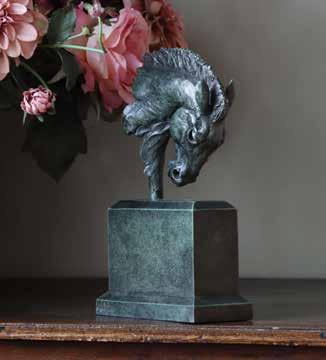
Edward Waites British (Contemporary)
Prowling Tiger
Bronze, (Edition of 12)
43 x 21 x 10 cms / 17 x 8¼ x 4 inches
£6,750
Warrior Horse Head Maquette
Bronze, (Edition of 15)
27 x 16 x 8 cms / 10¾ x 6¼ x 3¼ inches
£3,750
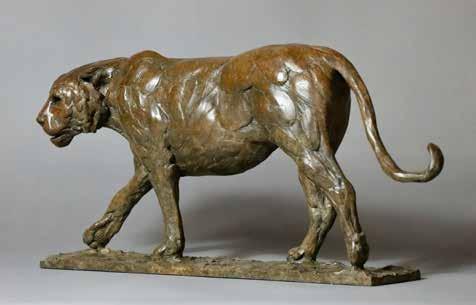
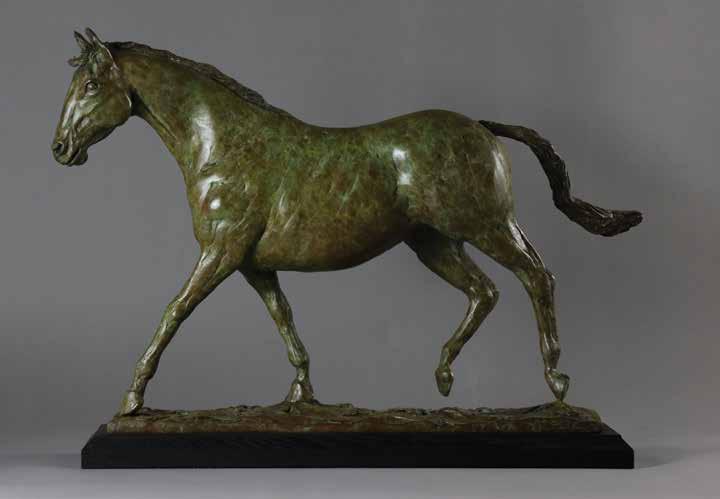
44 x 37 x 15 cms / 17¼ x 14½ x 6 inches
Agilis
Bronze, (Edition of 12)
£6,450
Nick Bibby
British (Contemporary)

Dormouse II (Climbing)
Bronze, (Edition of 12)
28 x 15 x 15 cms / 11 x 6 x 6 inches
£8,650
50 x 20.5 x 20.5 cms
19 ½ x 8 x 8 inches
£12,250

Little Owl II
Bronze, (Edition of 15)
Simon Gudgeon
British (Contemporary)
Geranos
Bronze, (Edition of 9)
152 x 48 x 10 cms / 59¾ x 19 x 4 inches
£19,500
Simon Gudgeon is one of Britain’s foremost contemporary sculptors, renowned for his ability to distil movement and emotion into elegant, simplified form. Working primarily in bronze, Gudgeon’s sculptures are characterised by their fluid lines and meditative presence, drawing deeply from the natural world for inspiration. Whether depicting wildlife or abstract forms, his work exudes a quiet power and refined grace.
Gudgeon’s background in law and painting led him to sculpture later in life, but he has swiftly achieved international recognition. His pieces are held in private and public collections worldwide and his monumental sculptures can be found in prominent outdoor settings including Hyde Park and the National Memorial Arboretum. His dedication to large-scale bronze work culminated in the creation of Sculpture by the Lakes, a 26-acre sculpture park in Dorset that he designed and founded with his wife Monique.
Geranos draws from the ancient Greek word for “crane” and evokes themes of harmony, ritual and flight. Its curved form suggests unity and movement, echoing Gudgeon’s lifelong interest in balance, between nature and form, stillness and motion. Cast in bronze, Geranos captures both strength and serenity, offering a timeless focal point for a garden or landscape.


James Doran-Webb British, (Contemporary)
The Falcon’s Focus
Molave Wood and Marine Grade Steel
199 x 56 x 24 cms / 78¼ x 22 x 9½ inches
£3,800
The Dance of the Peregrine Too Molave Wood and Marine Grade Steel
205 x 105 x 57 cms / 80¾ x 41¼ x 22½ inches
£4,500


Pieter Wagemans
Belgian, (Contemporary)
Bouquet de Fleurs
Oil on Panel
74 x 60 cms / 29¼ x 23½ inches
£9,950
Bathed in theatrical light, Bouquet de Fleurs by Pieter Wagemans is a rich, romantic still life that harks back to the great Flemish masters while retaining the freshness of a contemporary eye. Arranged against a sumptuous velvet backdrop, the porcelain vase bursts with roses, lisianthus and amaryllis, their petals rendered with astonishing delicacy. Pieter elevates each bloom beyond botanical study, capturing their vitality with a precision that speaks to decades of discipline.
Pieter has devoted much of his career to the challenges of floral painting. Each flower here is painted in turn from life, “alla prima,” then woven into an imagined composition. The result is a visual illusion: a bouquet that never truly existed in nature but appears effortlessly whole. Subtle vanitas motifs, the fallen petals, the antique silver box, lend the work a quiet symbolism, a reflection on the transience of beauty and time.
Pieter trained at the Royal Academy of Fine Arts under Jacques Gorus and Victor Dolphyn. He has exhibited widely across Europe, Asia and North America and his meticulous compositions are now held in prominent collections worldwide. His inspirations are clear. The luminous palettes of Rachel Ruyschand the structured elegance of William Claesz Heda appear to further inform his compositions.. But it is Pieter’s own sense of harmony, his unfailing attention to light and texture, that gives this painting its arresting sense of presence. Bouquet de Fleurs is not simply a study in florals, it is a masterclass in atmosphere and poise.
Stewart Lees
British (Contemporary)
Dappled Sunlight
Oil on Gesso Panel
60 x 80 cms / 23½ x 31½ inches
£23,000
Painted in the artist’s garden in Southern France, Dappled Sunlight is infused with the warmth and rhythm of late summer. Sunlight plays across the canvas in soft fragments, filtered through climbing vines and the broad leaves of Mediterranean shrubs. At the centre of the composition, a splash of vivid red from Stewart’s beloved geraniums anchors the scene - an expressive flourish amidst the subtle tonal variations that fill the rest of the painting.
Stewart’s garden is more than a place of retreat, it is a living studio. Many of the plants that appear in his work are ones he has cultivated by hand and the ceramic pots, weathered tables and earthenware jugs often glimpsed in the background are sourced from his frequent visits to the markets of rural France. These elements lend his paintings a rich sense of texture and narrative born from a life immersed in his surroundings.
A seasoned draughtsman with roots in graphic design and illustration, Lees brings clarity and refinement to each composition. In this work, it is the softness of the light and the quiet invitation to pause that resonates most deeply. Dappled Sunlight is less a study of a place than a moment, of warmth, stillness and the timeless pleasure of watching the afternoon light fall over familiar things.

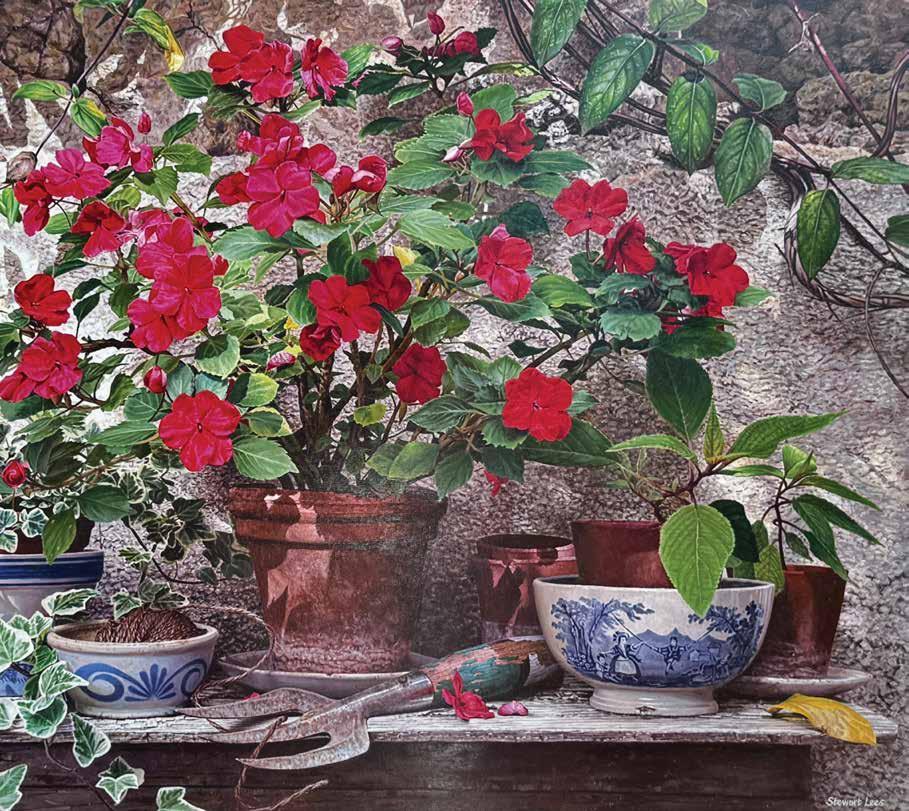
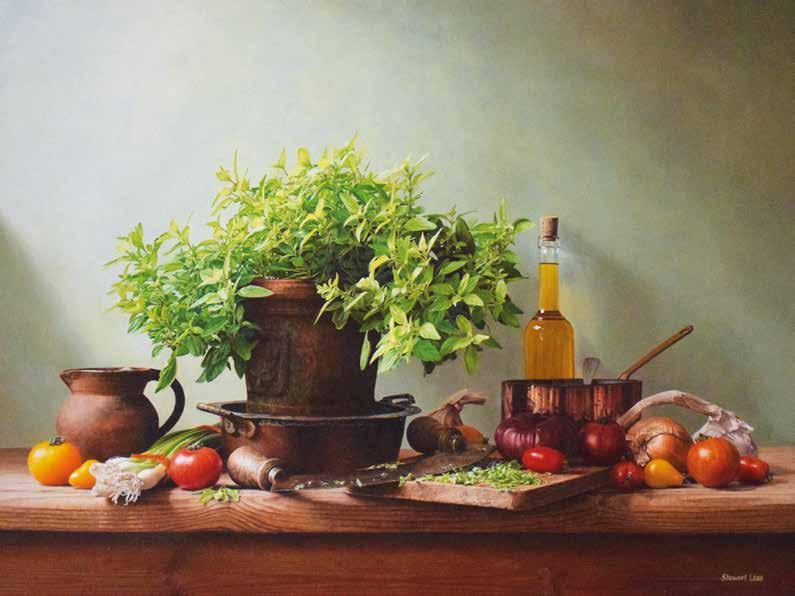
Left Page: Marinara
Oil on Gesso Panel
60 x 80 cms / 23½ x 31½ inches
£19,500
Right: Parmesan and Pesto
Oil on Gesso Panel
30 x 40 cms / 11 ¾ x 15 ¾ inches
£7,250
Stewart Lees
British (Contemporary)
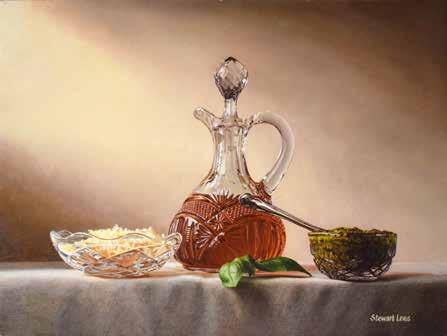
Like the dish from which it takes its name, Marinara is built from layers of flavour, each element thoughtfully chosen, balanced and composed. Stewart begins not with a rigid plan, but with an ingredient: a ripe tomato, a sprig of rosemary, a cracked earthenware bowl. From there, the arrangement grows, guided by instinct and memory, until a still life emerges that is both deliberate and deeply personal.
Stewart’s work is rooted in observation, but never confined by it. In Marinara , the warmth of the Mediterranean palette evokes sun-soaked kitchens and weathered wood table tops. There is a tactile richness to each brushstroke, the glossy skin of a tomato, the powdery softness of flour, the cool gleam of ceramic, all painted with fidelity to texture and tone. As in the best cooking, restraint is as important as richness; Stewart allows space and light to flavour the scene as much as any object.
The Connoisseur’s Collection
Paul S. Brown
American (Contemporary)
This exquisite series by Paul S. Brown is a feast in every sense - an indulgence not only of flavour, but of sight, atmosphere and storytelling. Inspired by the luxurious pairings of fine cheese and wine, The Connoisseur’s Collection is a celebration of taste and craftsmanship, elevated by Paul’s exceptional still life compositions.
A true Classical Realist, Paul’s focus is on universal beauty. He upholds rigorous standards in pursuit of this, working from life, emulating the techniques and materials of the old masters. This devotion to craftsmanship is evident throughout his paintings, from the soft skin of a peach to the soft gleam of pewter and the delicate transparency of a wine glass.
Each painting offers a moment of quiet opulence: the crumble of cave-aged cheddar, the ooze of Brie de Meaux, the golden glow of Vin Santo. These are everyday indulgences elevated into visual theatre. Like a carefully structured tasting menu, the series builds in tone and complexity, from rustic restraint to rich chiaroscuro. Subtle motifs, a cheese wire reappearing and fruits echoed across canvases, bind the sequence into a harmonious whole, inviting the viewer to savour each work as one might a fine course: slowly, and with delight.

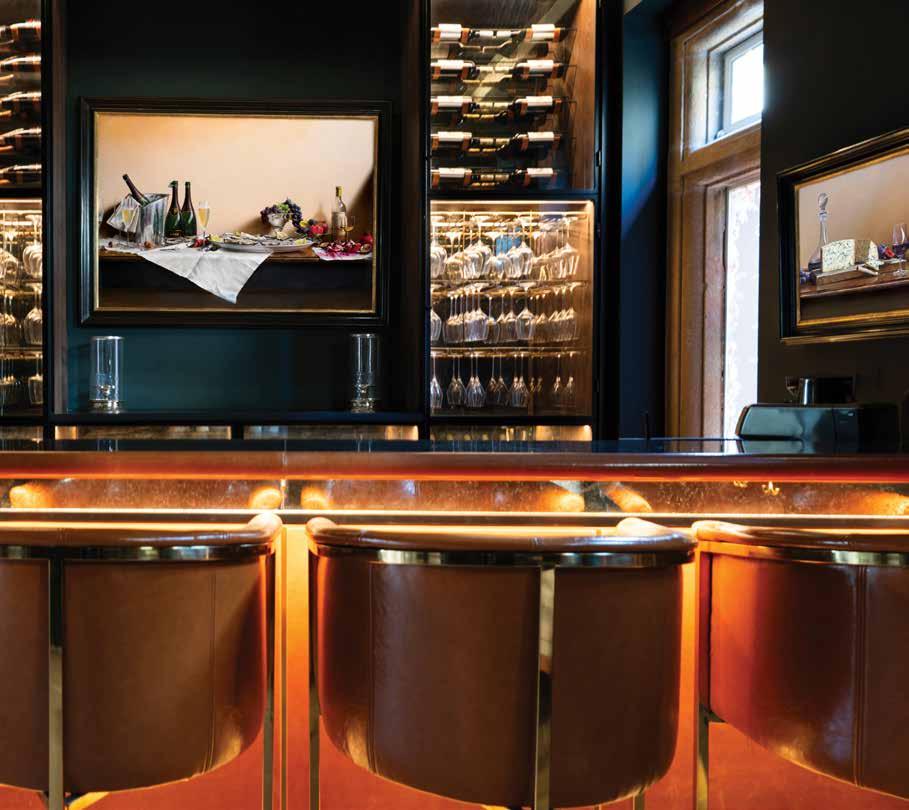
Paul S. Brown American (Contemporary)

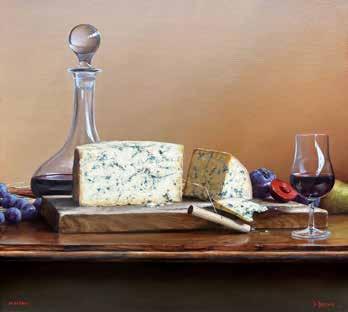
25.5 x 30.5 cms / 10 x 12 inches
£5,950
40 x 45 cms / 15¾ x 17¾ inches
£9,250
Cave Aged Cheddar Truckle
Oil on Canvas
Cropwell Bishop Creamery Stilton, Nottinghamshire and Port
Oil on Canvas
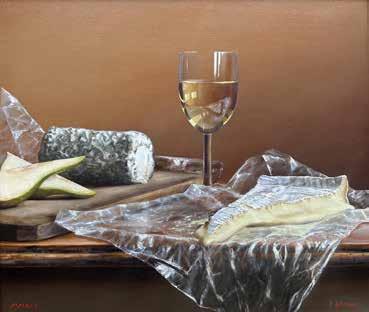

30 x 35 cms / 11¾ x 13¾ inches
£7,500
Oil
25.5 x 30 cms / 10 x 11¾ inches
£5,950
Driftwood White Lake Cheese Somerset Goat’s Cheese and Brie de Meaux
Oil on Canvas
Gorgonzola Dolce and Vin Santo
on Canvas


Paul S. Brown American (Contemporary)
In Full Swing
Oil on Canvas
90 x 130 cms / 35½ x 51¼ inches
£35,000
Few paintings so completely evoke the pleasure of the table as Paul S. Brown’s In Full Swing . This still life is a celebration of indulgence: oysters shucked and glistening, lemon wedges cut and poised, champagne fizzing in freshly poured flutes. Paul brings every element to life with extraordinary technical precision. Reflections in the silver ice bucket dance with light, while the cool gleam of pewter and the textured napkin ground the composition in tactile realism.
The painting’s opulence builds from centre to edge. Grapes, plums and a split pomegranate spill from silver bowls, their deep hues echoed in the golden Sauternes glowing in its glass. An opened bottle of Château d’Yquem 1983, one of the greatest vintages of the twentieth century, adds a note of quiet splendour.
Like the grandest seventeenth-century Dutch still lifes, this composition is as much about story as it is about abundance. Paul’s mastery of Classical Realism, honed during his studies at the Florence Academy of Art and through decades of meticulous practice, lends every detail, weight and atmosphere. In Full Swing captures a fleeting moment of pleasure and renders it timeless, transforming a shared feast into a work of enduring beauty.
Eric De Vree
Belgian, (Contemporary)
Eric De Vree’s still lifes offer a quiet, meditative pause. They are contemplative arrangements that speak to a deep reverence for craftsmanship and classical tradition. Drawing on the heritage of the Dutch Golden Age, De Vree composes his subjects with meticulous balance: antique books, bunches of grapes, porcelain vessels and ink pots are staged with an intuitive sense of rhythm and restraint. The soft glow of light against dark grounds recalls the chiaroscuro of Rembrandt, revealing the sculptural form of each object with remarkable clarity.
Raised in Antwerp and trained by his father, the etcher and landscape painter Albert De Vree, Eric developed a rigorous foundation in classical painting. His approach is informed by both technical precision and painterly sensitivity. Whether rendering the velvety sheen of a grape or the chalky patina of an aged bottle, he invites the viewer to look longer and closer.
De Vree’s compositions remain rooted in tradition but are never static. A scattering of crumbs, a loosely draped cloth, a flicker of spontaneous light, all inject vitality and a whisper of narrative into the scene. These are still lifes that bridge centuries: intimate, timeless and quietly extraordinary.


Eric De Vree Belgian, (Contemporary)
The Quill Pen
Oil on Panel
68.5 cms x 83.5 cms / 27 x 32¾ inches
£25,000
The Scholar’s Table
Oil on Panel
55 x 60 cms / 21¾ x 23½ inches
£15,000
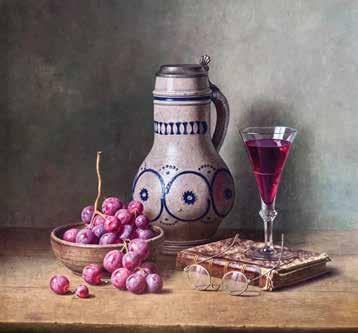
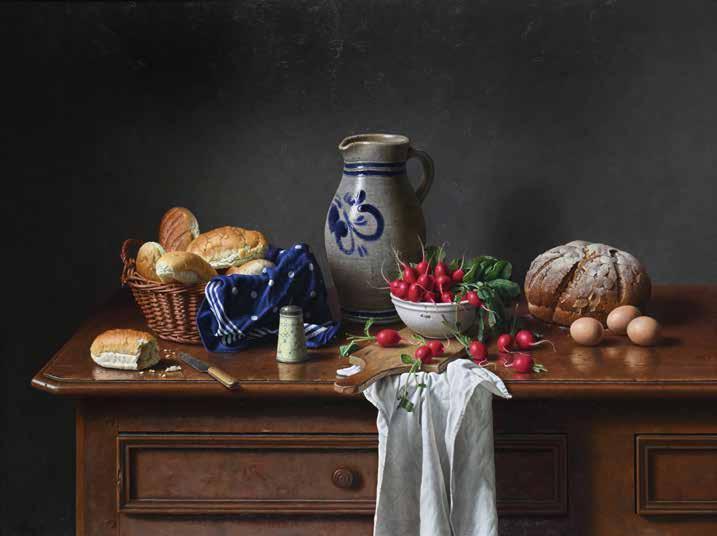
The Full Dresser
Oil on Panel
82 x 110 cms / 32¼ x 43¼ inches
£29,500

Spanish School (19th Century)
92 x 73 cms / 36¼ x 28¾ inches
£5,950
L’Atelier du Peintre
Oil on Canvas
Pierre Grisot French, (1911-1995)


24 x 19 cms / 9½ x 7½ inches
£1,950
55 x 46 cms / 21¾
£2,950
Jeune Femme au Parapluie
Oil on Canvas
x 18 inches
Femme devant la Fontaine de la Concorde
Oil on Board

Willem Johannes Martens Dutch, (1839-1895)
The Silk Ribbon Oil on Panel
40 x 32.5 cms / 15¾ x 12¾ inches
£5,950
Victor Joseph Chavet
French, (1822-1906)
26 x 20 cms / 10¼ x 7¾ inches
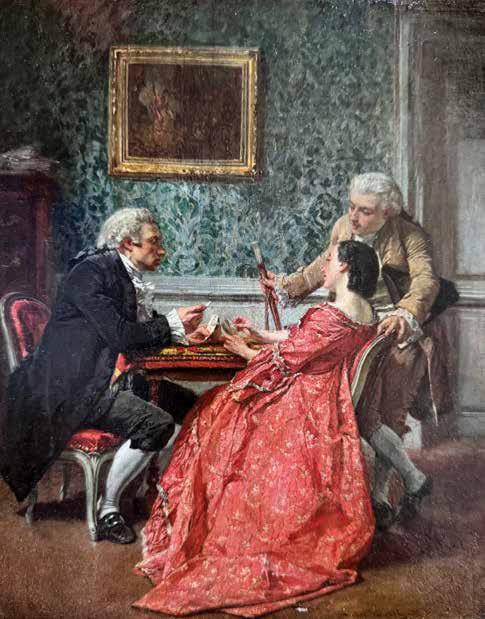
The Card Game
Oil on Panel
£3,950
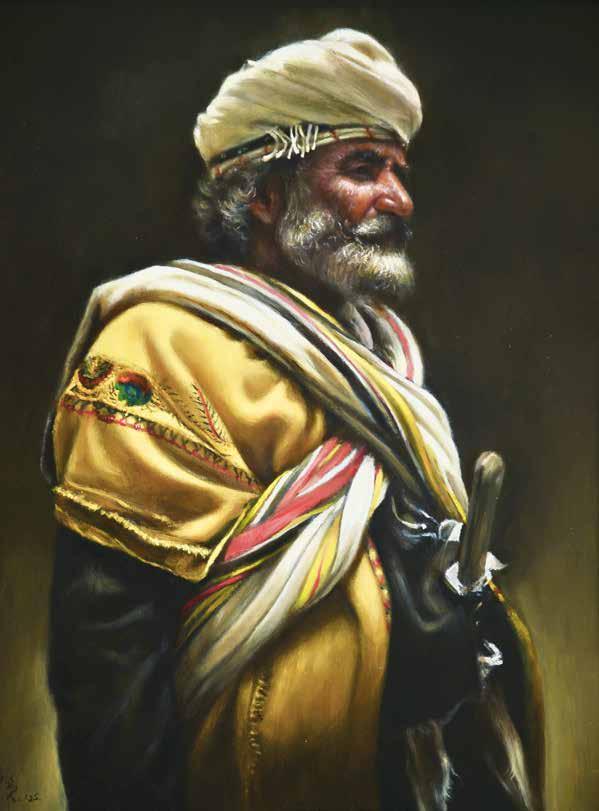
Aris Raissis Greek, (Contemporary)
The Old Guard Oil on Panel
40 x 30 cms / 15¾ x 11¾ inches
£9,900
A Noble Lady Oil on Panel
40 x 30 cms / 15¾ x 11¾ inches
£9,900
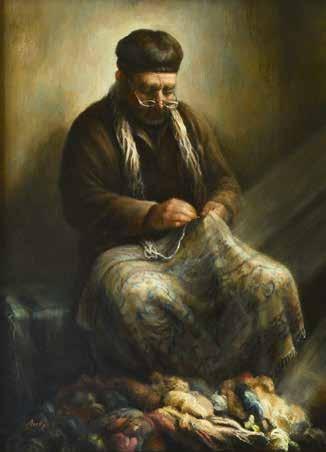

on Panel
40 x 30 cms / 15¾ x 11¾ inches
£8,300
Cashmere Oil
Donald Hamilton Fraser British (1929-2009)

23 x 30 cms / 9 x 12 inches
£11,500
Faraid Head IV
Oil on Paper

Peter Wileman
Georges Terzian
French, (1939-2021)
La Petite Guitare
Oil on Panel
38 x 46 cms / 15 x 18 inches
£6,500
Joyful, rhythmic and intensely graphic, La Petite Guitare encapsulates the unmistakable visual language of Georges Terzian. Across its surface, musical instruments, patterned textures and angular planes harmonise in a richly orchestrated composition. The titular guitar, flattened and reassembled in fragments, is flanked by amphora-like vases and architectural forms outlined in confident black. Bold colours of turquoise, ochre, scarlet and green, lend the work a carnival energy, while subtle detailing, like the diamond-shaped motif and stylised scroll, nods to Terzian’s layered cultural inspirations.
Born in Marseille in 1939 to Armenian parents, Terzian was a polymath from the start, a trained artist, a shoemaker and a cabaret singer in 1960’s Paris. His formative years at the École des Beaux-Arts in Marseilles grounded him in classical technique, yet it was Cubism that would shape his mature voice. Terzian absorbed the legacies of Picasso, Braque and Léger, yet imbued them with personal lyricism and theatricality. His musical training resonates through every canvas: La Petite Guitare has the cadence and syncopation of a jazz improvisation, dynamic yet composed.
The artist’s enduring fascination with pattern, structure and sound is evident in the architectural order behind the seeming spontaneity of his forms. From his studio in Paris, Terzian has continued to create works that celebrate colour, movement and cross-cultural influence. This composition, modest in scale but bold in execution, is a vivid example of his distinctive post-Cubist style, at once referential and entirely his own.


André LHote
French, (1885-1962)
Solitude en Bleu
Gouache and Watercolour on Paper
38 x 25 cms / 15 x 9¾ inches
£19,500
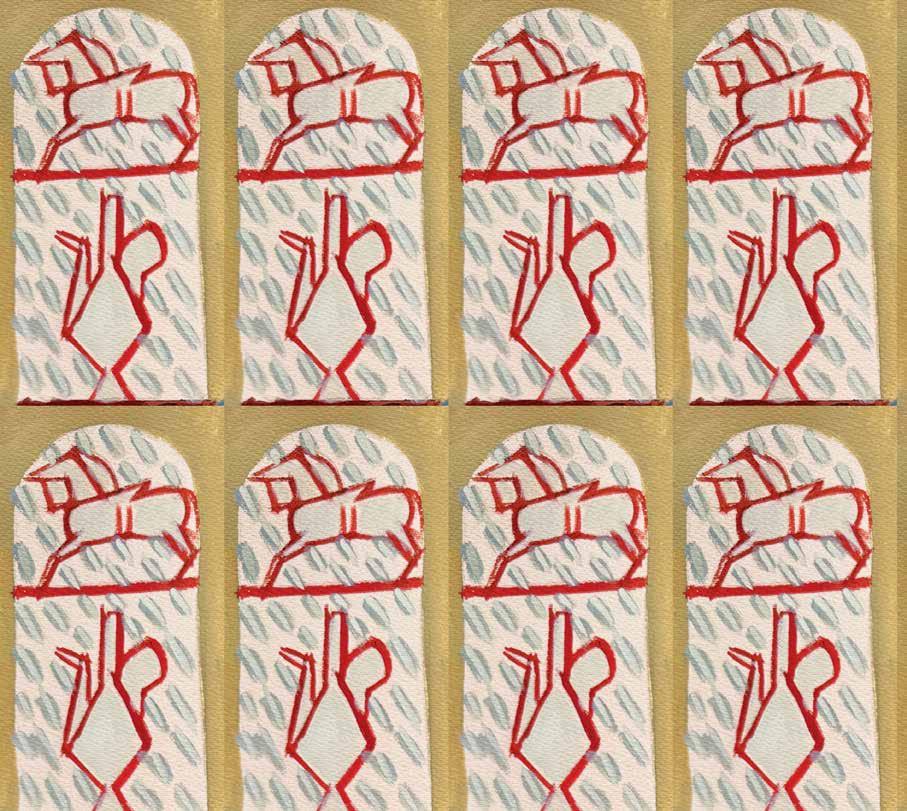
With angular grace and a palette of cool restraint, Solitude en Bleu exemplifies André Lhote’s refined interpretation of Cubism at mid-century. Painted in 1948, this portrait of the artist’s wife and muse, Marguerite Hayet, captures not only the geometry of form but the stillness of introspection. Her tilted head, elongated neck and folded hands form a rhythmic arrangement of intersecting planes, softened by harmonies of blue, ochre, rose and sage.
Lhote’s early training as a woodcarver and decorative sculptor is evident in his structural approach to the figure. He studied at the École des Beaux-Arts before settling in Paris, where he became one of Cubism’s most articulate and enduring proponents. A founding member of the Section d’Or and a committed teacher, Lhote sought balance and legibility in his abstractions, favouring clarity over fragmentation.
The composition is grounded by subtle domestic elements: a red chair, and behind the sitter, two simplified objects - a sculpture of a horse and a jug - arranged on shelves within the interior setting. Solitude en Bleu stands as a serene and elegant expression of Lhote’s mature style: a synthesis of intimacy and order, of Cubist structure and human depth.
A NEW GLADWELL & PATTERSON ONLINE EXPERIENCE
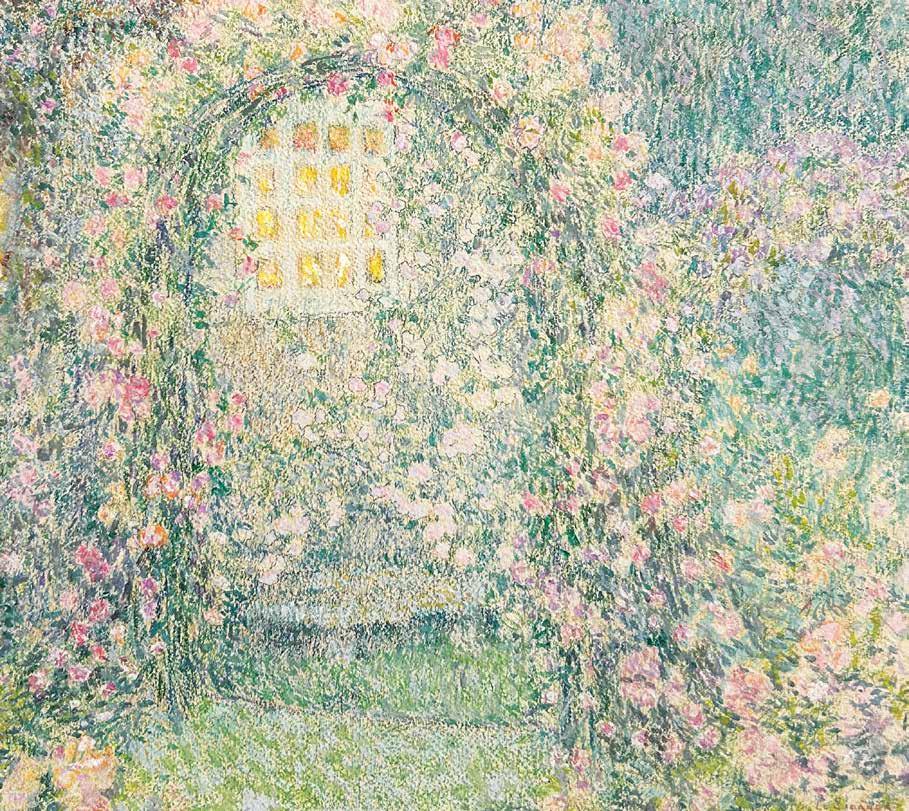



Georgina Potter: A Solo Show
Georgina Potter is fast becoming one of Gladwell & Patterson’s most sought-after contemporary en plein air artists. We are delighted to present her first solo exhibition. This carefully curated collection celebrates the breadth of her recent work, capturing landscapes from across Britain and Europe; from the soft light of rural pastures and dramatic coastal scenes to snow-covered peaks, quiet farmland and ancient, time-worn ruins.
Stamford PE 9 2 AL
From 10 - 31 October 2025
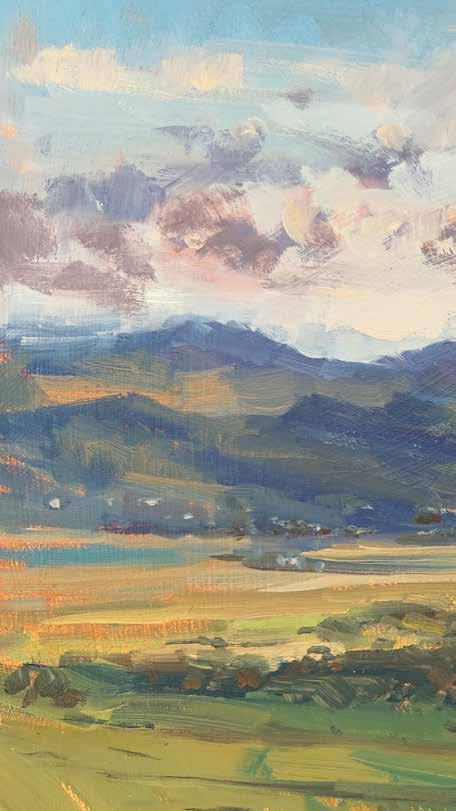

Index
Nick Bibby p 74-75
Pierre Bittar p 32
Auguste Bouvard p 62-63
Alfred de Breanski p 54-55
Peter van Breda p 60-61
Paul S. Brown p 86-91
Yvonne Canu p 30-31
Gustave Cariot p 4-5
Victor Joseph Chavet p 99
Gabriel Deschamps p 34
James Doran-Webb p 78-79
Marcel Dyf p 25
Andrè Hambourg p 114-115
Donald Hamilton Fraser p 102
Edgar Freyberg p 49
Simon Gudgeon p 76-77
Yvon Grac p 33
Pierre Grisot p 97
Émil-Bénédiktoff Hirschfeld p 48
Alexandre Louis Jacob p 20-21
Jean Kevorkian p 36-37
Stewart Lees p 82-85
André Lhote p 106-107
Henri Le Sidaner p 26-27
Gustave Loiseau p 22-23
Willem Johannes Martens p 98
Maurice Martin p 16-19
Jules Masuré p 44-45
Ronny Moortgat p 46-47
Charles Perron p 38-39
Fernand Pinal p 28
Lucien Potronat p 35
Georgina Potter p 110-111
Aris Raissis p 100-101
Georges Charles Robin p 12-15
Edward Seago p 50-53
David Shepherd p 64-69
Spanish School p 96
Peter Symonds p 56-57
Martin Taylor p 58-59
Georges Terzian p 104-105
Anthony Theakston p 70-71
Raymond Thibésart p 38-43
Eric de Vree p.92-95
Pieter Wagemans p 80-81
Edward Waites p 65, 72-73
Peter Wileman p 103
Raymond Wintz p 40-43
With special thanks to the following:
Tim Steele for his wonderful photography at No. 1 High Street, Stamford
